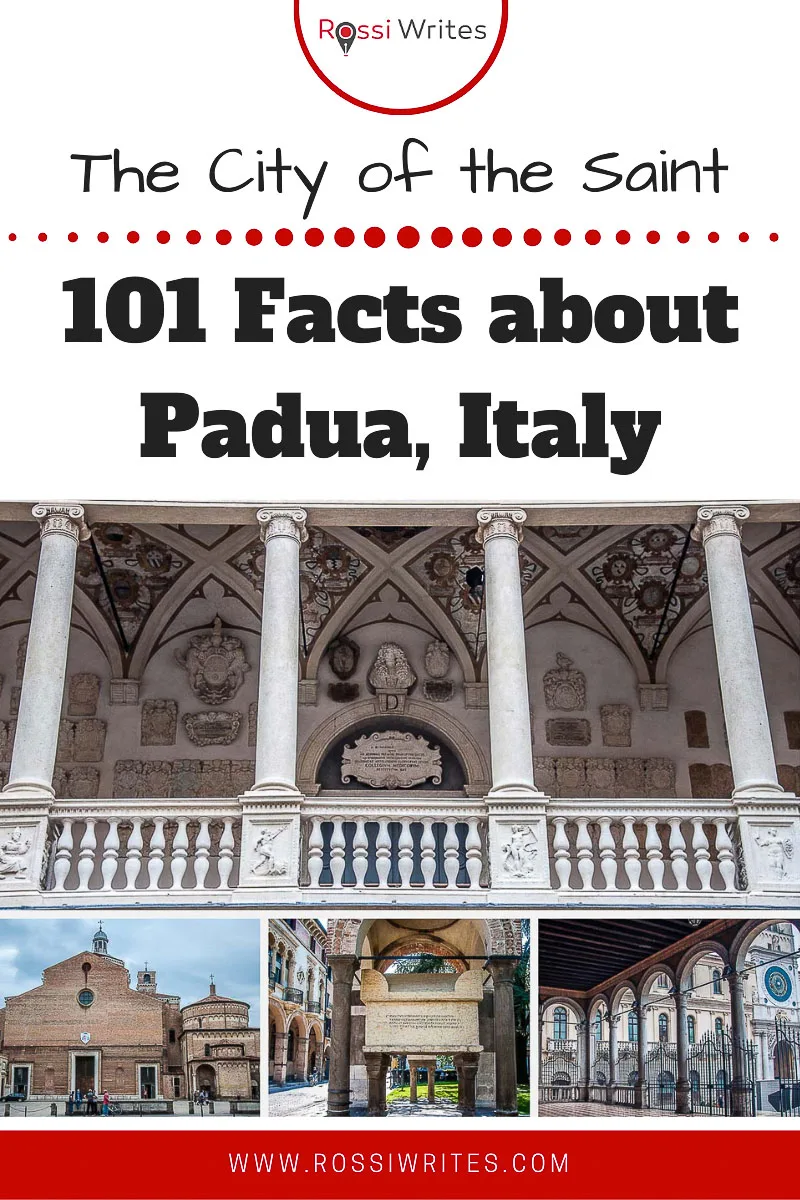Padua in Italy is a great travel destination that often gets overlooked for the nearby tourist magnets of Venice and Verona.
Yet, Padua has lots to offer to the traveller looking for an authentic Italian experience.
This is a city rich in art, history, and culture. A place where good food has centuries-old traditions. And above all, a destination that is not besieged by tourist crowds.
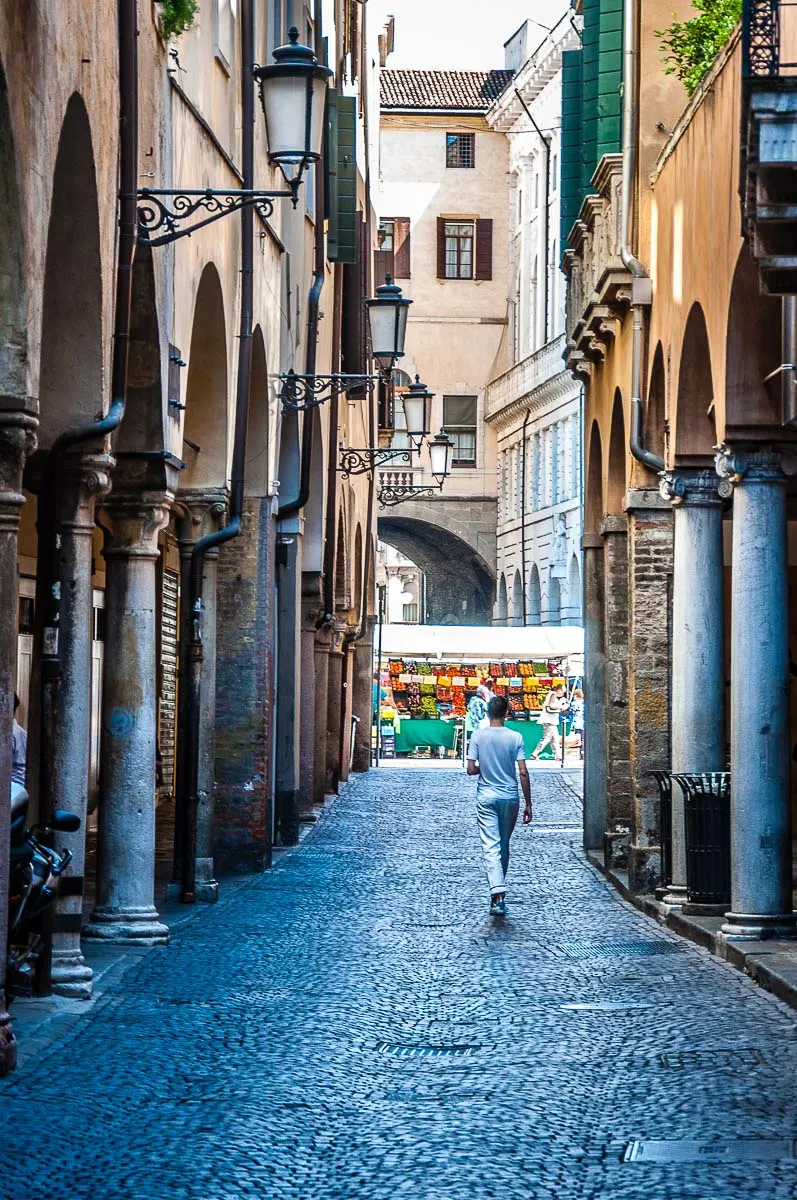
The most fascinating thing about Padua though is that it sits at the crossroads of science and religion. For, on one hand, this is the city where St. Anthony is venerated to the point of being simply called Il Santo (The Saint), the same way you would call your parents simply mum and dad.
Hence Padua’s moniker is the City of the Saint.
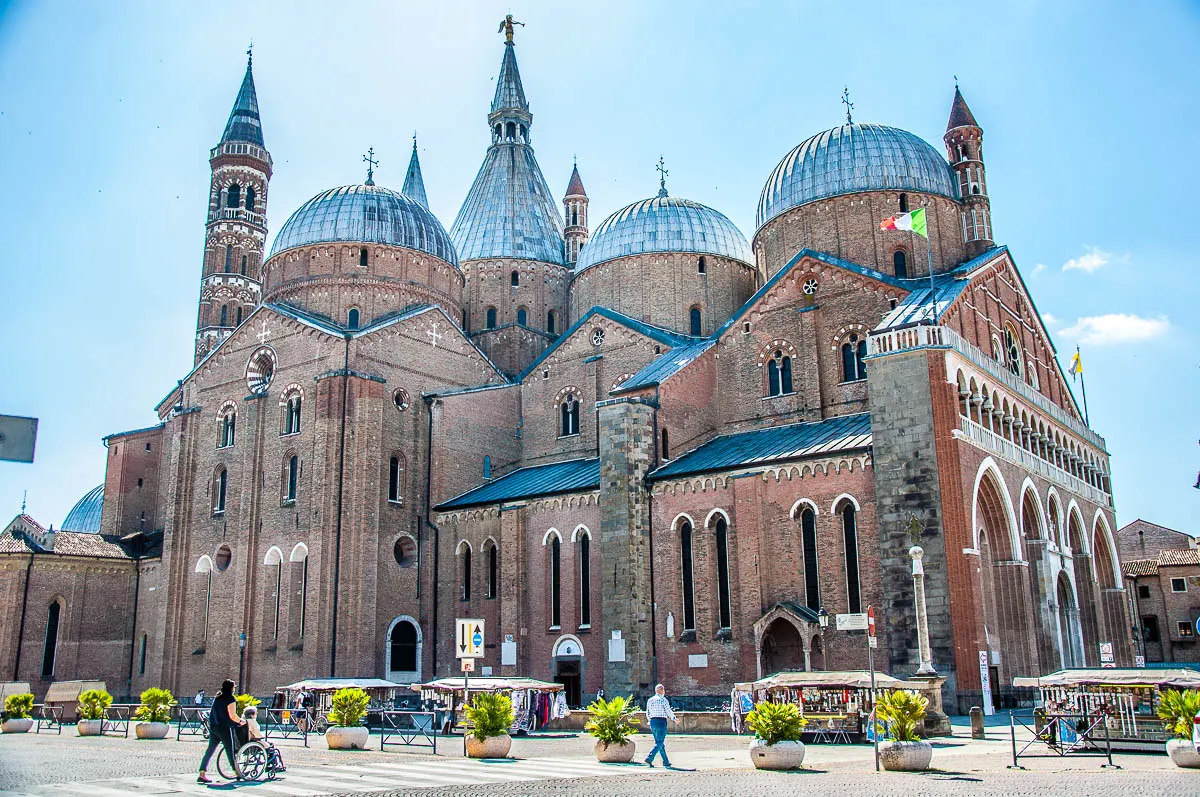
On the other hand, Padua is the place where the second oldest Italian University was established in 1222. Throughout the centuries, famous scientists taught and studied in it. Among them was Galileo Galilei who called his 18 years in Padua ‘the happiest in his life’.
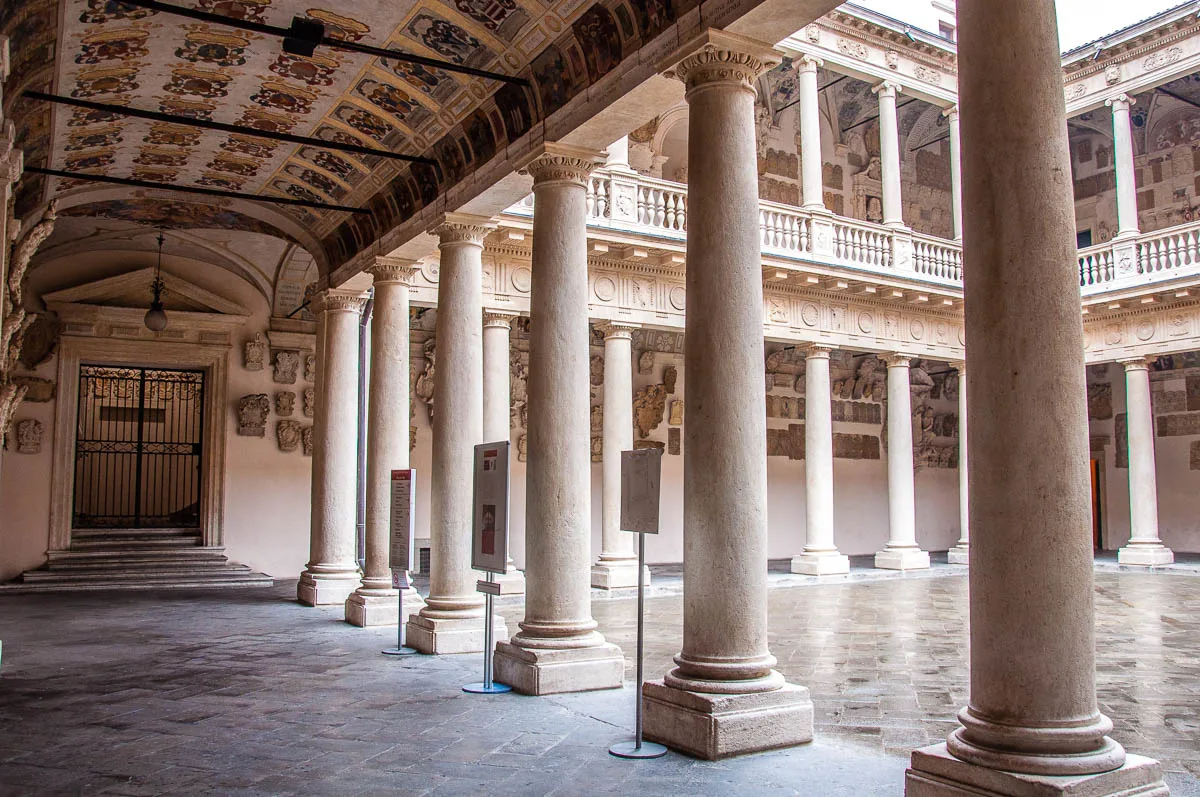
The relationship between religion and science in Padua, Italy is not exactly symbiotic, though. Both occupy different layers of the city with art, history, and culture wedged between them.
This makes Padua even more exciting to explore. You can literally choose which of its faces to see or opt to have a multifaceted approach to this Italian city.
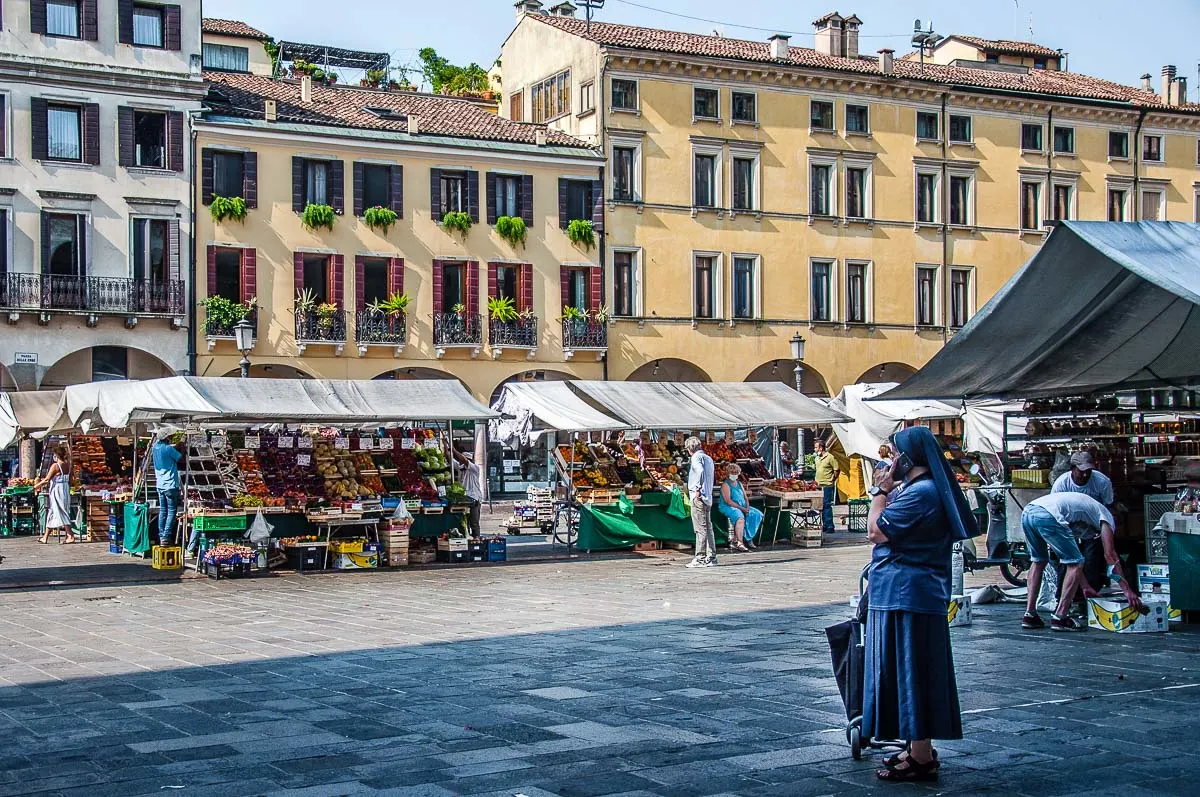
Padua’s millennial history is the intriguing backdrop to it all. Ancient civilisations settled and prospered here. Most importantly, to this day Padua continues to be a flourishing city with a lively vibe to it.
If all this has picked your curiosity and you want to learn about Padua a bit more, this blog post will come in very handy. It gives you 101 facts about ten different facets of this Italian city. From science to religion, from history to art, and from food to important personalities that left their imprint on Padua, the information included here covers many topics. As such, it gives you a good understanding of what the city stands for. It also guides you to the sights that are relevant to the different facts.
So, you can use this blog post as a thematic travel guide and as a source of inspiration and ideas for your explorations of Padua, Italy.
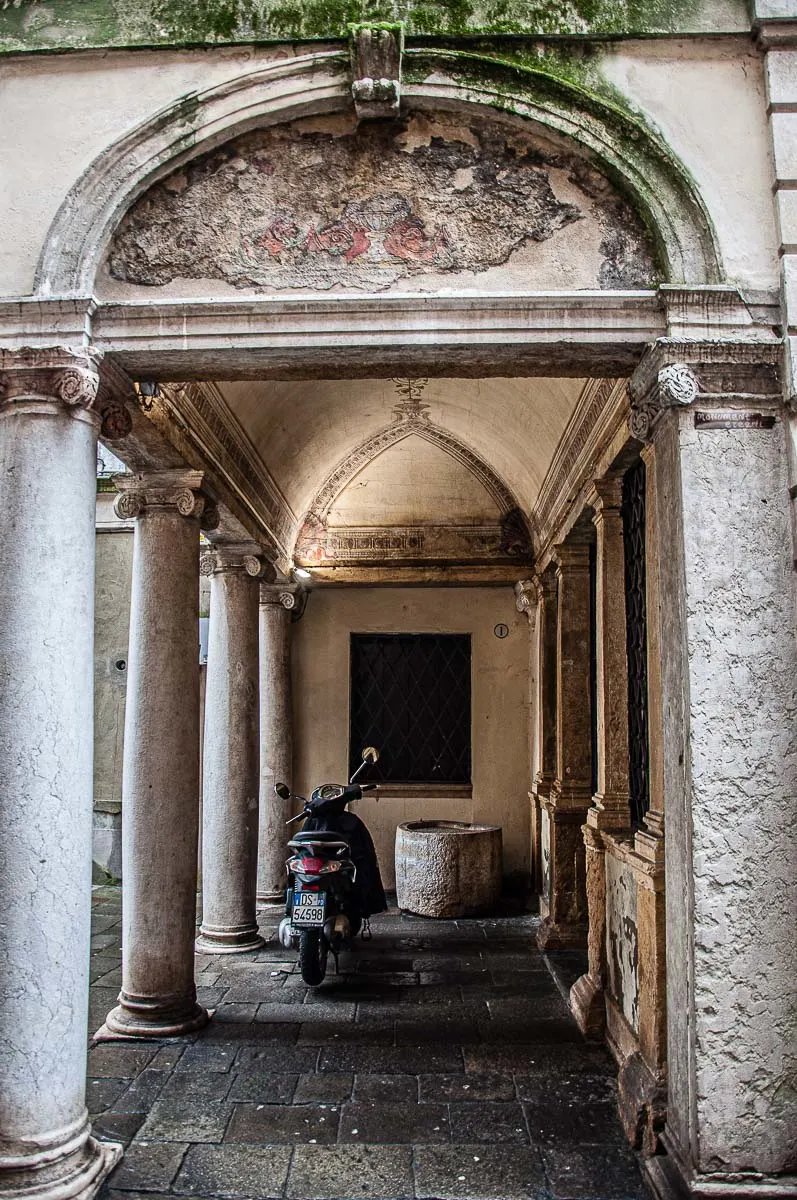
Through these 101 facts, I introduce you to Padua the way I saw this beautiful Italian city over the six years that I spent living nearby. I often travelled there for day trips, sometimes up to ten times a month. Discovering Padua’s secrets one by one, lifting the veil over its many facets, was one of the greatest pleasures of my life in Italy.
So, read on! I hope that by the end of this extensive list you will be just as fascinated by Padua in Italy as I am. And, hopefully, you will put it on your travel wish list to visit and explore in detail as and when the right time comes along.
Enjoy!
Padua, Italy – 101 Facts About the City of the Saint
I. Facts About the Name of Padua, Italy
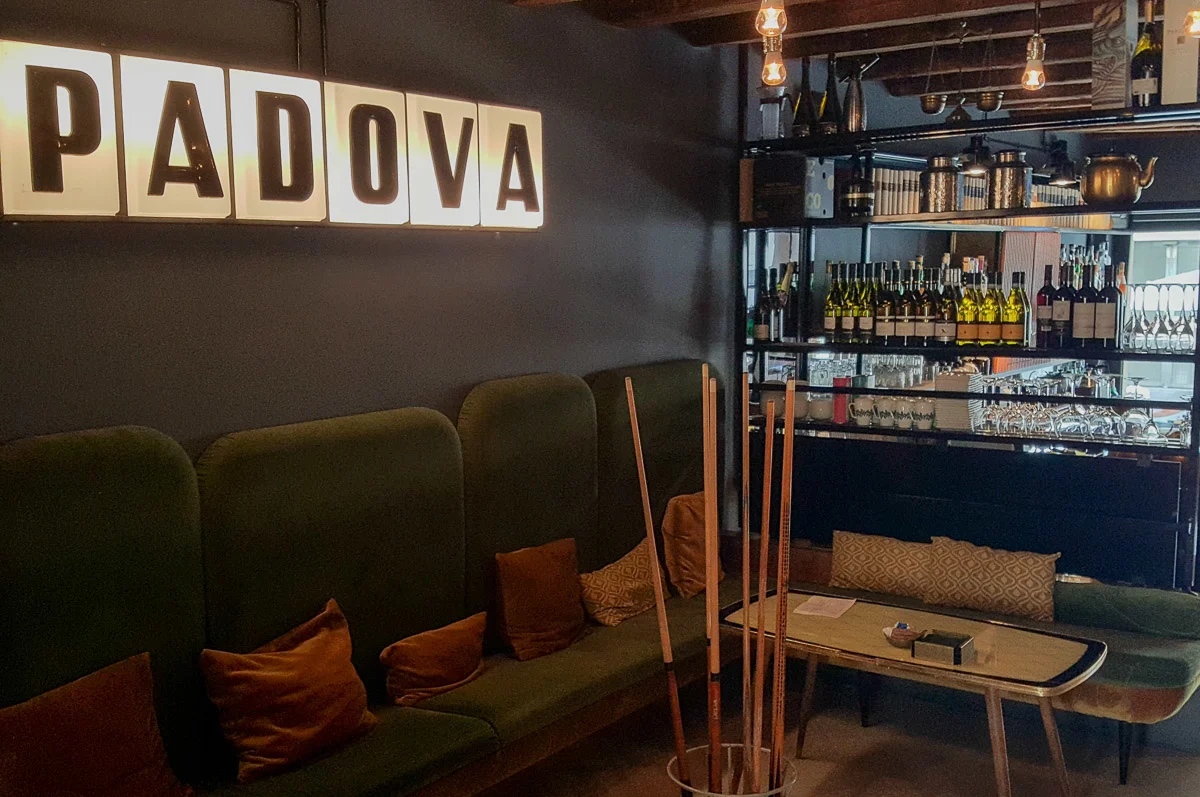
Padua’s name derives from Patavium – the city’s ancient name. This, apparently, was pronounced as ‘Patauium’.
Although its etymology is not certain, one theory is that Patavium was based on Padus – the old name of the River Po. Yet another theory states that Patavium probably came from the Gaulish word ‘padi’ meaning ‘pine’.
Nowadays, Padua’s name in Italian is Padova. In English and many other languages, the city is known under its medieval Latin name – Padua. This itself was based on Padoa – the name of the city in the Venetian language. This was the language spoken in the Republic of Venice of which Padua became part in 1405.
The current Italian form of the city’s name – Padova – is actually based on the Tuscan dialect which was accepted as the language of culture in Italy and standard Italian was based on it.
By the way, you can see the Padova sign in the picture above in a lovely coffee shop called Caffeine in the centre of Padua.
II. Facts About the History of Padua, Italy
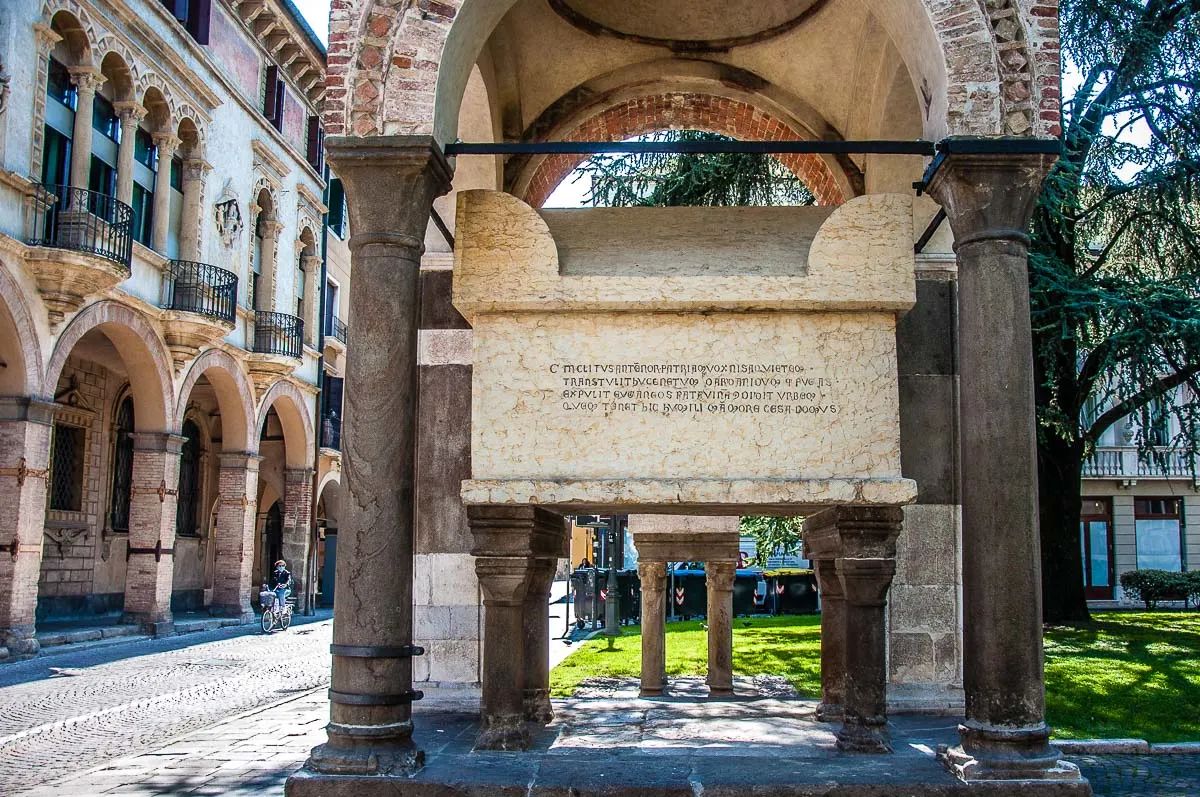
Padua was founded in 1183 BC. This makes Padua 430 years older than Rome! Some even consider Padua to be the oldest city in Northern Italy.
According to the myth (apparently corroborated by Virgil’s Aeneid), Padua was founded by Antenor. He was a Trojan prince and a counsellor of King Priam of Troy. Antenor, actually, advocated for the Beautiful Helen to be returned to the Greeks.
It is believed that after the fall of Troy, Antenor led the tribe of the Eneti (also called Veneti) – who were allies of Troy – from what nowadays is Northern Turkey to the lands around the river Brenta in what nowadays is the Northern Italian region of the Veneto. There he founded Padua in 1183 BC.
In fact, nowadays you can see Antenor’s Tomb in the centre of Padua. The photo above shows you what it looks like. Antenor’s Tomb is just a few steps away from Palazzo Bo – the historical seat of the University of Padua. For centuries it was believed that the large sarcophagus contained the remains of the Trojan hero. Unfortunately, in 1985 modern technology dispelled this belief. Still, the Antenor’s Tomb remains a must-see sight in Padua.
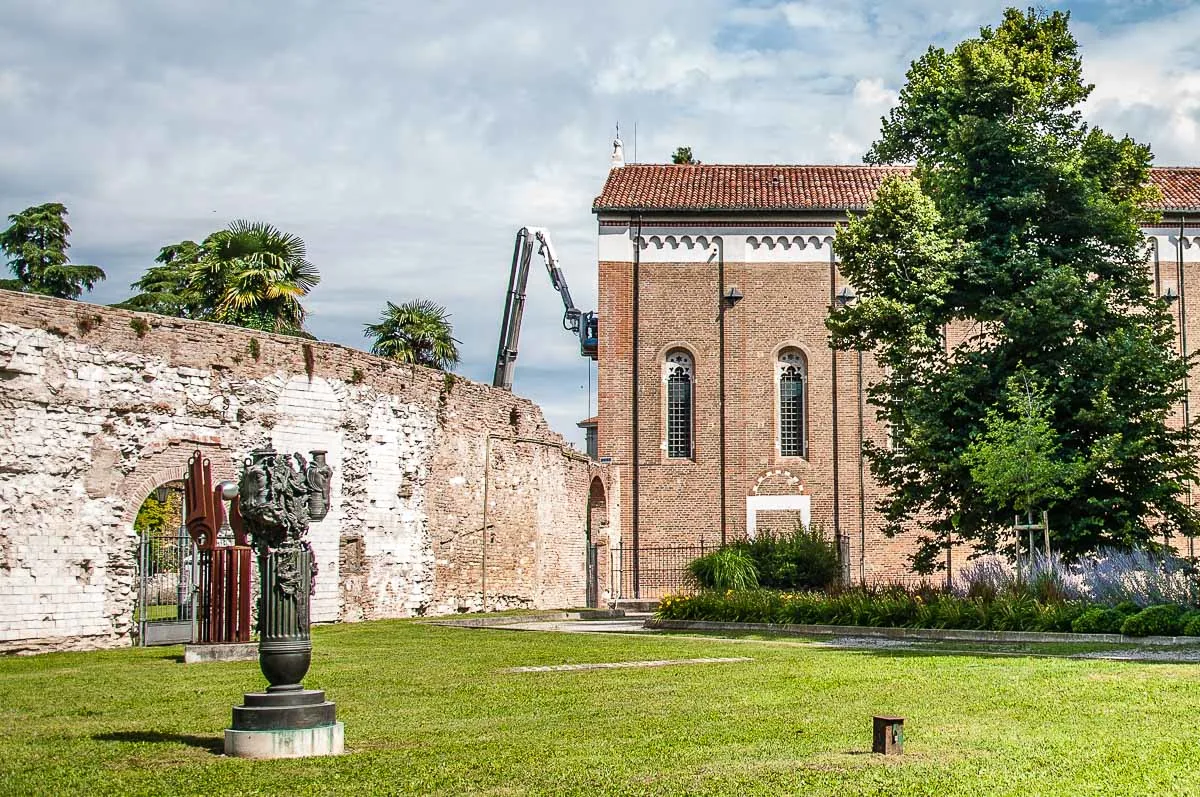
Padua became an ally of Rome in 226 BC and a Roman municipium in 49 BC. Several bridges, an arena and a river port were built at that time. There was also an attempt to regulate the waters surrounding the city.
Many Roman roads crossed Padua including Via Annia. It connected the city with important Roman centres and stimulated commerce.
By the end of the 1st century BC, Padua is alleged to have been the richest city in Italy after Rome. With its 40,000 inhabitants and wealth based on horse breeding and the production of wool and woollen garments, Padua was also famous as a place of strict morals, unlike Rome.
To learn more about the ancient history of Padua, a visit is recommended to the city’s Eremitani Civic Museums. The Archaeological Museum which is part of them has a very well-curated collection shedding light on life in and around Patavium before and during its Roman period.
Between the 5th and the 9th centuries AD Padua was sacked several times. The Huns of Attila in 450 AD and then the Magyars in 899 AD cruelly pillaged the city. The result is that not much of its Roman heritage has survived to this day. For example, nowadays you can see the remains of the Roman arena of Padua in the park Giardini dell’Arena, right next door to the world-famous Scrovegni Chapel (please, see the above photo). Or you can take a guided tour of the underground area of the medieval town hall Palazzo della Ragione to see the Roman and medieval ruins there.
The bloodiest siege that Padua suffered during this period lasted 12 years! It started after the citizens of the city rose against Agilulf – the Lombard king. In 601 AD, the Lombards stormed the city after the long siege and burned it. Many citizens of Padua took refuge on the islands in the Venetian Lagoon thus contributing to the creation of Venice. It took Padua centuries to return to its former glory.
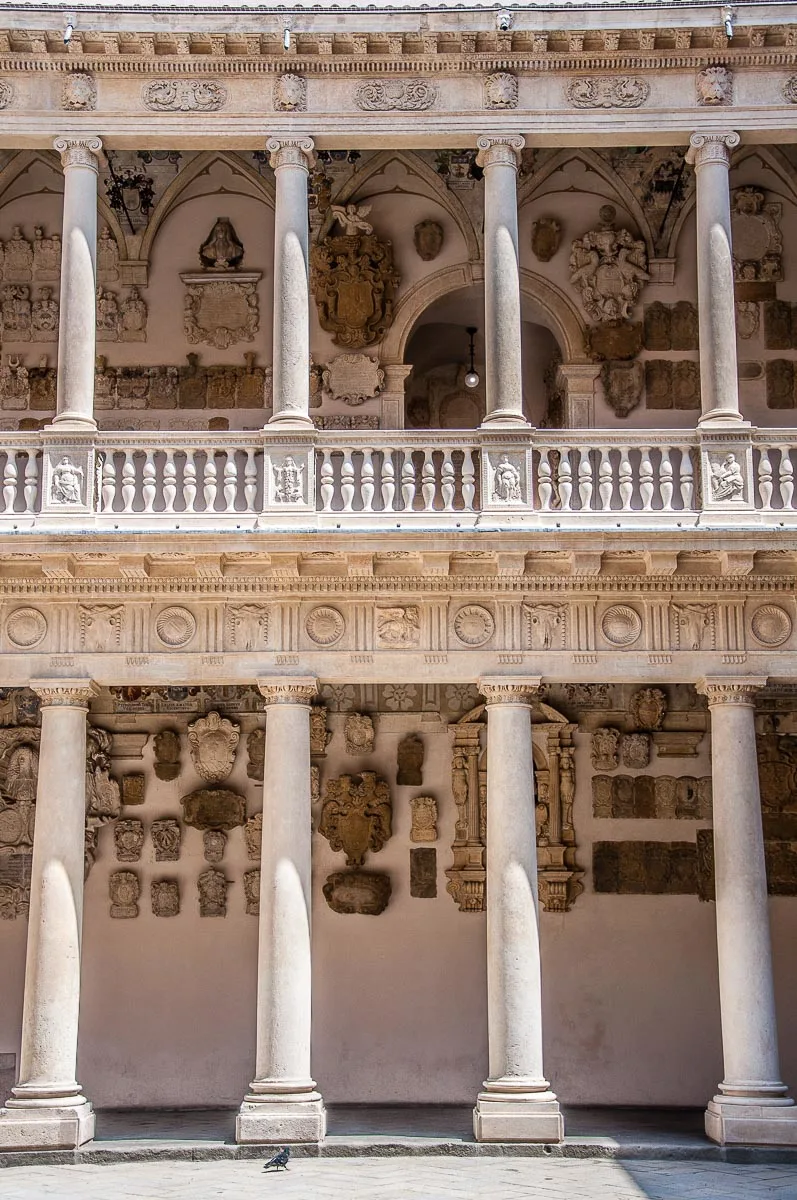
Padua functioned as a free comune in the 11th, the 12th, and the beginning of the 13th centuries. Unfortunately, the city was beffalen by grave misfortunes – from devastating earthquakes to a city-wide fire. Still, one of the most important things that happened here during this period was the foundation of the University of Padua in 1222.
This is the second oldest University in Italy and it has a long and illustrious history. Nowadays, you can visit the splendid Palazzo Bo – which became the University’s seat in 1539 – and take a guided tour to learn more about it. Above, you can see a photo of the courtyard of Palazzo Bo.
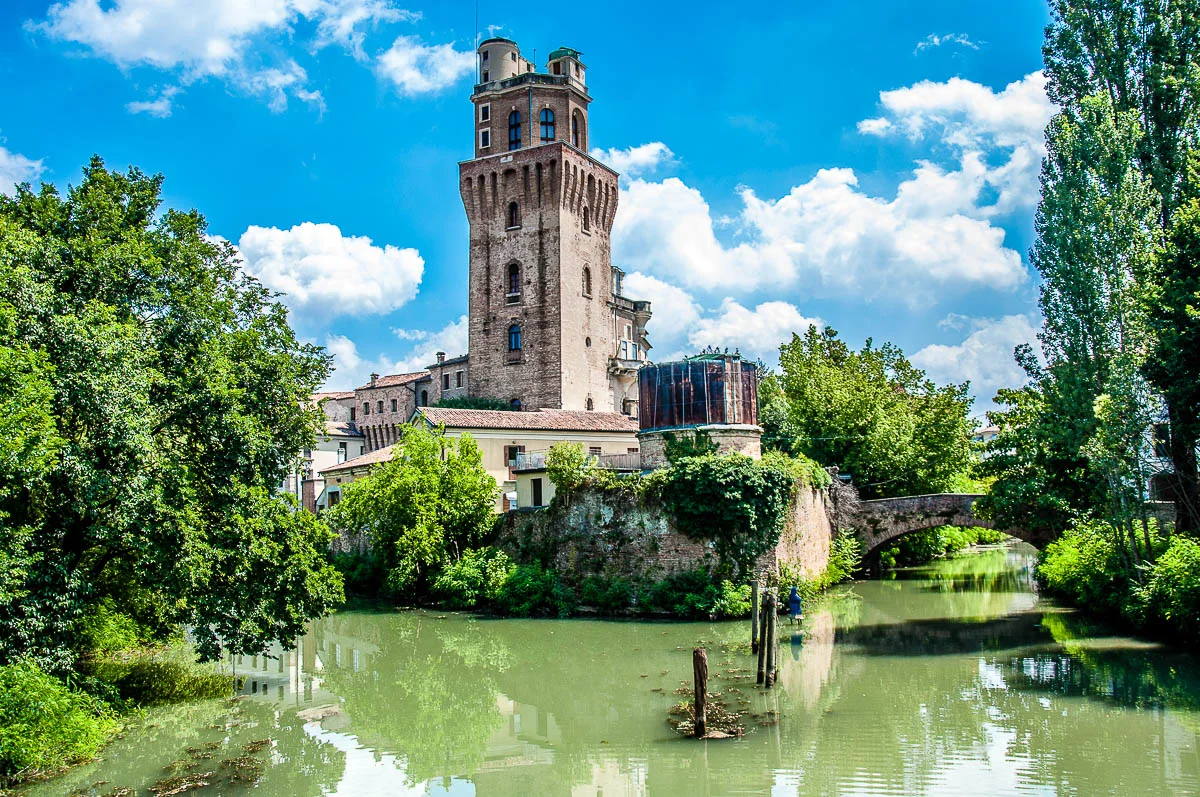
In the 13th century, Padua was subjugated by the medieval warlord Ezzelino III da Romano. His cruelty was such that Dante depicted him in the depths of Hell in his Divine Comedy. A number of sights from this period survive in Padua to this day, most notably La Torlonga.
This is a tall tower (pictured above) which was used by the tyrant as a prison. There are several ghostly legends connected to it which you can read here. The tower was restructured significantly through the centuries. In the 18th century, La Torlonga became an astronomical observatory and the people of Padua began calling it La Specola (in English, The Observatory). Nowadays, the tower serves as the Museum of Padua’s Astronomical Observatory.
During most of the 14th century, Padua was ruled by the medieval Carrara dynasty. Nowadays, you can see the tombs of two of its members in the Church of the Eremitani here. The church also has precious frescoes by Guariento and Andrea Mantegna, so a visit is highly recommended. You will find it right next door to the Eremitani Civic Museums.
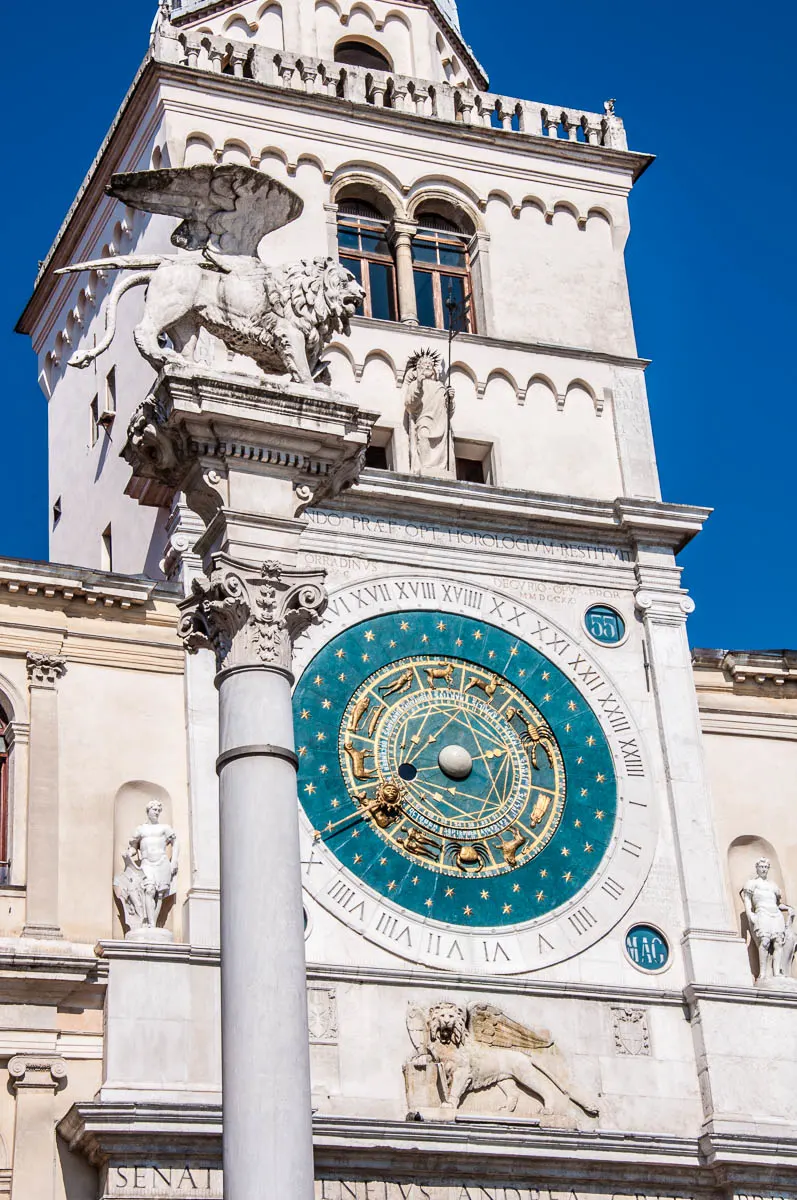
In 1405, Padua was conquered by the Republic of Venice. The Venetians ruled here until the fall of their Republic in 1797. There are many vestiges of this period all over the city. Most notably, you can see the winged Venetian lion adorning many facades and standing on top of a pillar at the city’s historic Piazza dei Signori, as illustrated above.
Throughout its history, Padua had a complex defensive system of walls and ramparts. These were built in four phases: Roman, 13th century (medieval walls), 14th century (Carraresi’s walls) and 16th century (Renaissance walls, also known as Venetian walls).
Padua’s Renaissance (or Venetian) defensive walls were built between 1523 and 1544. They made the city impregnable. These walls and their gates are still standing to this day, almost entirely intact. They are beautiful to look at, walk on and take photos of.
The Austrian Empire ruled over Padua (as part of its Kingdom of Lombardy-Venetia) from 7th November 1813. With the Treaty of Vienna in 1866, Padua joined the then newly established Kingdom of Italy.
III. Facts About the Main Sights of Padua, Italy

Padua has a very interesting historic centre with countless sights and places to explore over several days. The most important sights can be seen in a day (if you stick rigidly to this proposed schedule). To truly capture the city’s spirit, be prepared to spend at least two days here.
The Scrovegni Chapel is Padua’s most famous sight. Small in size, made of bricks and on the edge of the city’s historic centre, its beauty is truly on the inside. The chapel was fully frescoed around 1305 by the Florentine artist Giotto and his students. The Biblical scenes depicted here are replete with human emotions. For this, the fresco cycle is universally considered to be the first masterpiece of the Italian Renaissance.
Visits to the Scrovegni Chapel follow a strict timetable and only a limited number of people are allowed in for each time slot. Tickets sell out quickly, so it’s recommended to book well in advance.

Palazzo Bo – the historic seat of the University of Padua – houses the world’s first permanent anatomical theatre. It was constructed there in 1594. Made of wood and with, they say, intentionally uncomfortable benches, so that the students wouldn’t fall asleep, it was used to teach anatomy through dissections until 1872. For more details on this, have a look at the article I wrote for BBC Travel about Padua as the birthplace of modern medicine.
Nowadays, the anatomical theatre can be seen as part of the guided tour of Palazzo Bo. The tour is highly recommended. Among several other things here, you will also be shown Galileo Galilei’s podium from which he used to teach his highly popular lectures.

Padua’s Palazzo della Ragione is an early 13th-century medieval town hall. This is where meetings and tribunals deciding the fate of Padua and its citizens have been held for centuries. The palazzo has three floors. The top floor is taken entirely by the enormous Great Hall. The hall is fully frescoed with scenes depicting the Labours of the Months. The ground floor of the palazzo houses delis, fishmongers, butchers, bakeries, coffee shops, bars, and eateries selling traditional local food. The underground floor can be accessed only as part of a guided tour and this is where you can see Roman and early medieval ruins.
Two historical squares flank Padua’s Palazzo della Ragione. Their names are Piazza delle Erbe and Piazza della Frutta. A daily market has been held on them for the past 800 years. Nowadays, the market spills over on Piazza dei Signori – a third important historical square in Padua which is right next door to Palazzo della Ragione. Click here for extensive details about these three squares.
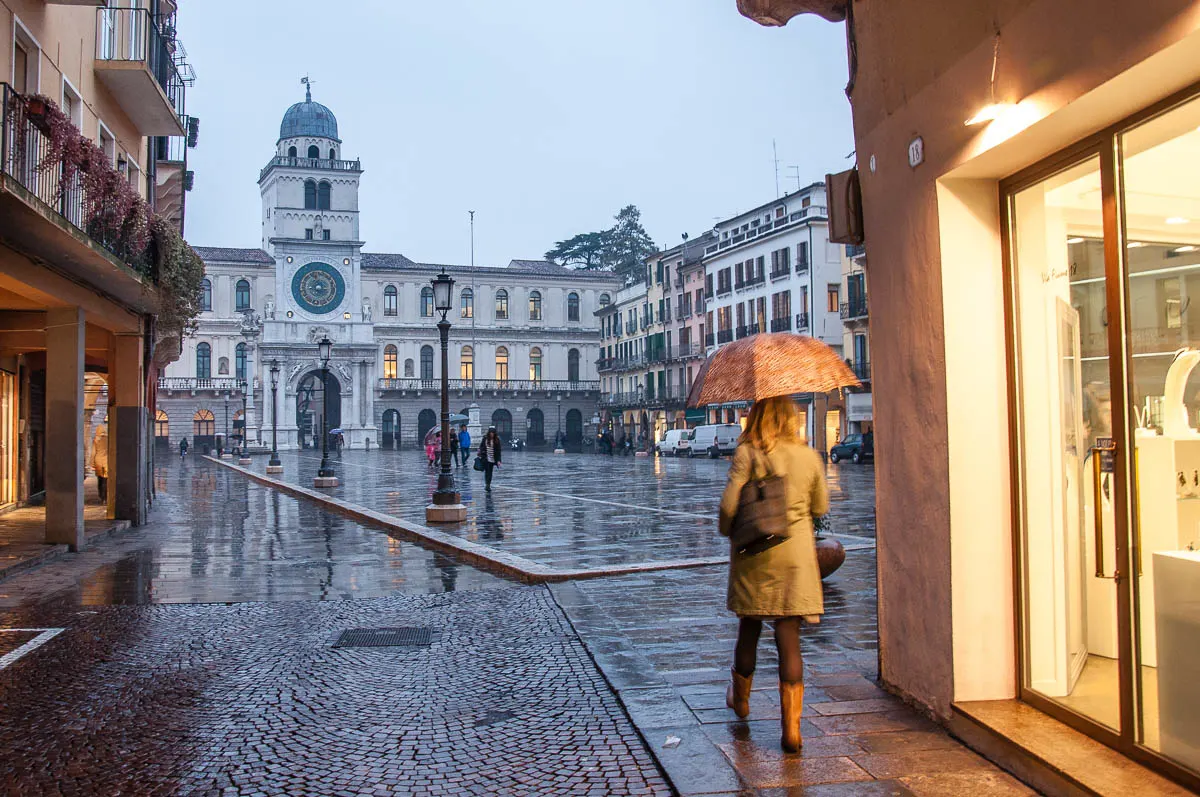
Piazza dei Signori has always been the hub of Padua’s power. Throughout the centuries, the palaces and the offices of many of the city’s rulers stood around this splendid square. It was also used as the stage for public ceremonies. Tournaments and festivals took place here. Nowadays, a daily market (Sundays excluded) sells homewares and bric-a-brac creating a lively atmosphere.
Piazza dei Signori is best enjoyed after the daily market has finished trading for the day and after all the stalls have been cleared away. Then you can truly appreciate the beauty of the square and the buildings which surround it.

Padua’s stunning astronomical clock is the crowning glory of Piazza dei Signori. Some consider it to be the oldest clock in the world. There are three curious things about it. One is that at noon the hour hand points straight down instead of straight up. This is because the dial is divided in 24 rather than 12 sections. Click here to find out the other two things.
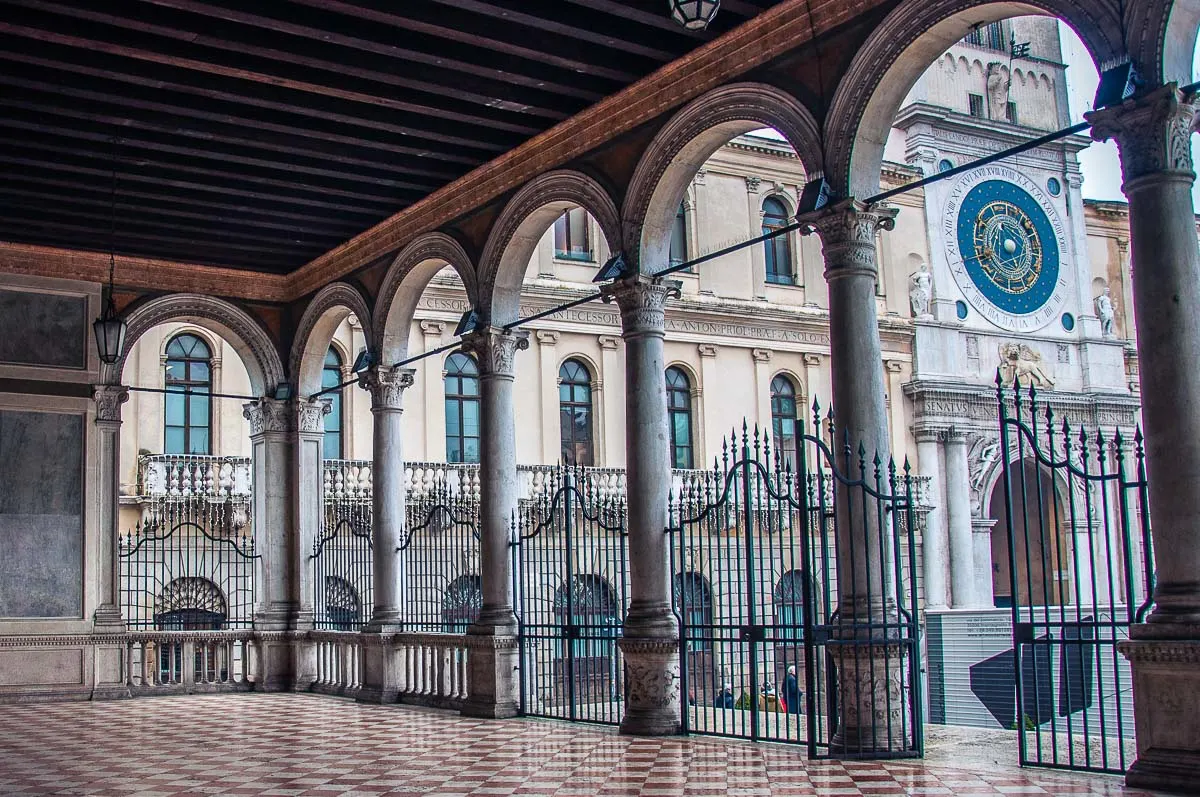
A lovely building you can admire at Piazza dei Signori, is the stunning Loggia del Consiglio (also known as the Loggia della Gran Guardia). This is where the Great Council of the City held its meetings after a large fire devastated in 1420 the nearby Palazzo della Ragione. During the Austrian domination of Padua, the loggia was used as military headquarters. Nowadays, it is a centre where exhibitions and cultural initiatives take place.
The Colonna Marciana is another historical sight on Padua’s Piazza dei Signori. This is a pillar on top of which stands a statue of the winged Venetian lion (Padua was part of the Republic of Venice from 1405 to 1797). The pillar was erected at that spot in the mid-18th century. Curiously enough, the pillar is made of parts which are much older than that. For example, the marble column and the capital are Roman and were discovered in 1764 near the Church of San Marco. It is thought that the column had been used in the colonnade of one of Patavium’s large wool markets along the river. The lion was sculpted in 1870 by Natale Sanavio to replace the one destroyed by the troops of Napoleon in 1797.
Across from the Colonna Marciana stands a large flagpole. It has a marble base from the 16th century. The marble panels on its four sides depict the cardinal virtues. The ancient Paduan measure brazz is chiseled on one of its steps. It corresponds to 64 cm. The chiseled measure was used to protect people from fraudulent market traders.
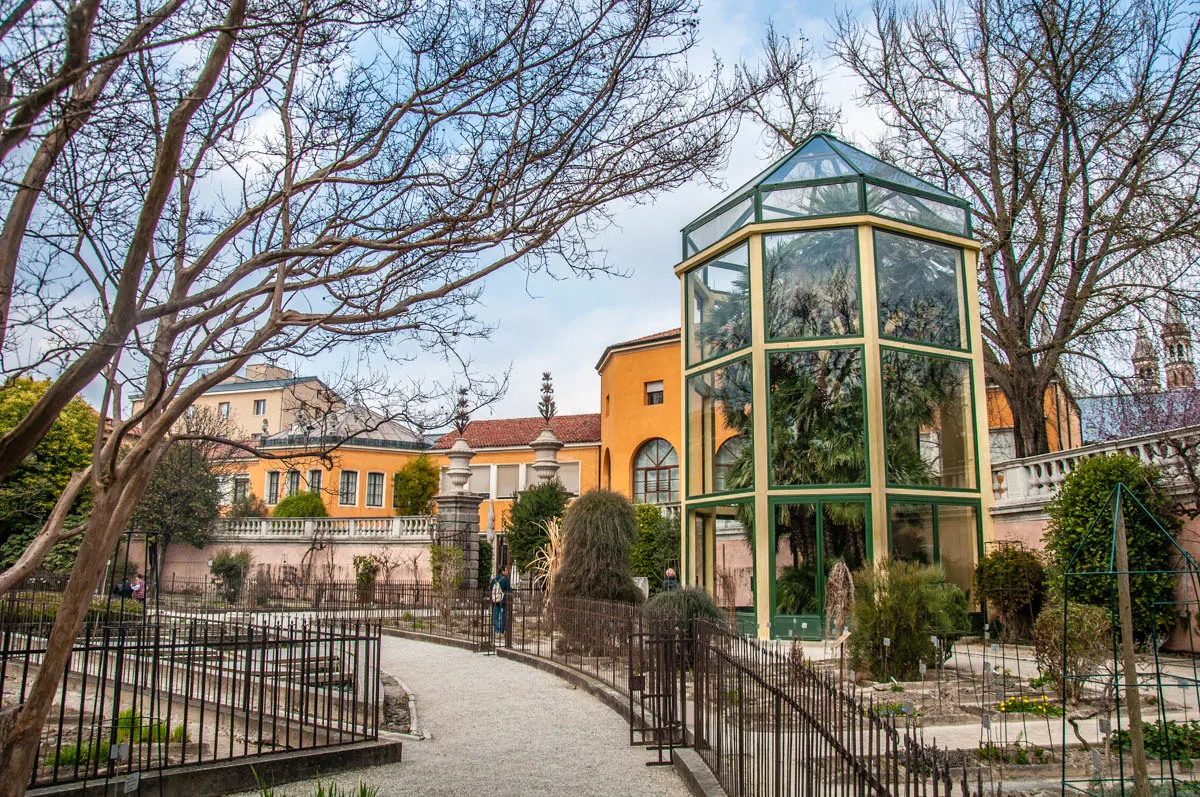
The University of Padua Botanical Garden is considered to be the oldest University Botanical Garden in the world. It dates back to 1545. The garden is a UNESCO World Heritage Site. It has over 7,000 botanical species and it’s a lovely place to spend an hour or two in. The garden has two parts: the Historical Garden which preserves its original 16th-century circular design and the modern Biodiversity Garden where the world’s major climate regions are replicated with their respective flora.
Goethe’s palm is one of the most noteworthy plants in the University of Padua Botanical Garden. The palm was planted in 1585 and nowadays it’s 10 m tall. It’s inside a small glass greenhouse which was built around it to protect it from the elements. The German poet, playwright, and scientist Johann Wolfgang von Goethe saw the palm tree during his visit to the Botanical Garden on 27th September 1786. It inspired him to describe his evolutionary theory in the ‘Essay on the Metamorphosis of Plants’. Hence nowadays, the palm carries Goethe’s name.
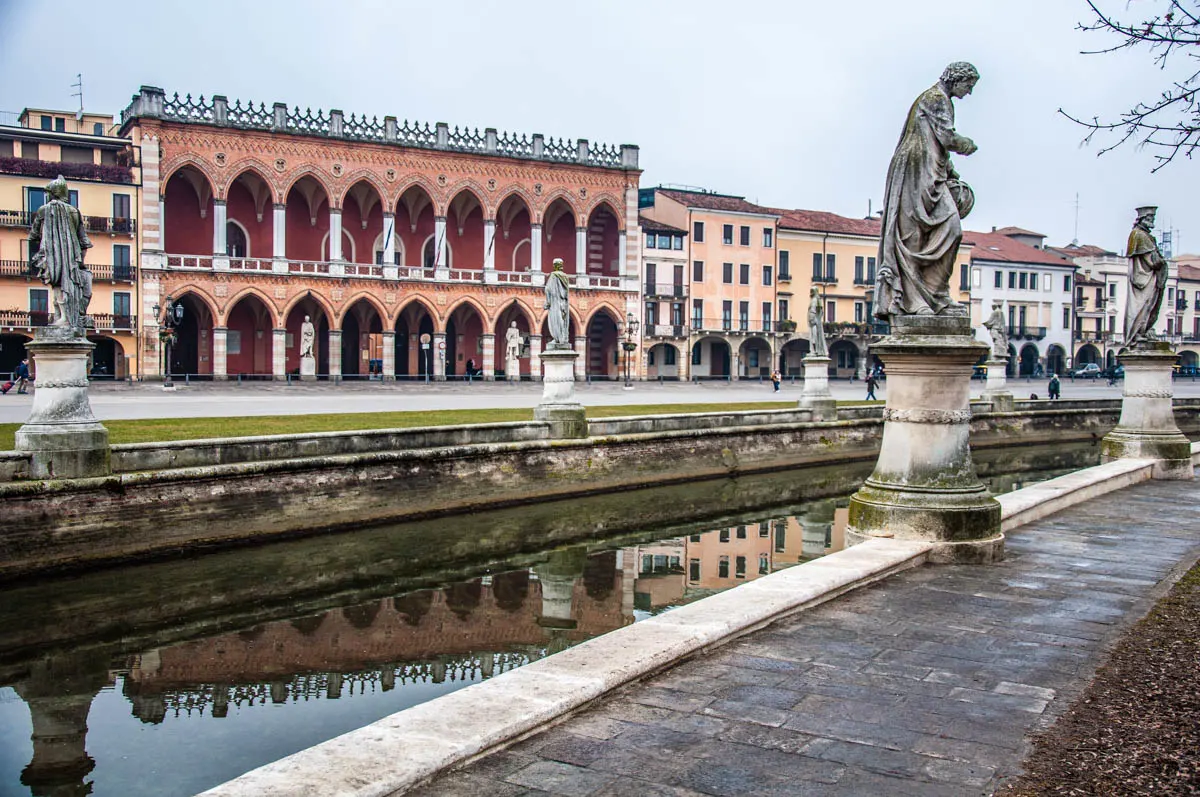
With its 90,000 sq m, Prato della Valle is the biggest square in Italy and one of the biggest in Europe. It was created in the 18th century by the Venetian nobleman Andrea Memmo. Hence the green space of the square nowadays is known as the Isola Memmia. Isola (Italian for island) because an elliptical canal runs all the way around Prato della Valle. Cute little bridges give you access to the ‘island’ in its centre.
Two rings of statues stand on both sides of the elliptical canal. They are 78 in total and represent famous people who have influenced the development of the arts and sciences in Padua. Originally, there were 88 statues here. After the fall of the Republic of Venice in 1797, Napoleon ordered the destruction of the statues of the Venetian Doges.
Today Prato della Valle is a great place to go for a walk. The square also regularly holds markets, festivals, parties, and city-wide events.
Many elegant and historic buildings surround Prato della Valle. One of the most striking ones is the Loggia Amulea. This neo-Gothic building used to be the headquarters of Padua’s firefighters for most of the 20th century. Nowadays, it houses different offices and a hall where civil matrimonies are performed. A statue of the great Italian poet Dante stands in front of the Loggia.
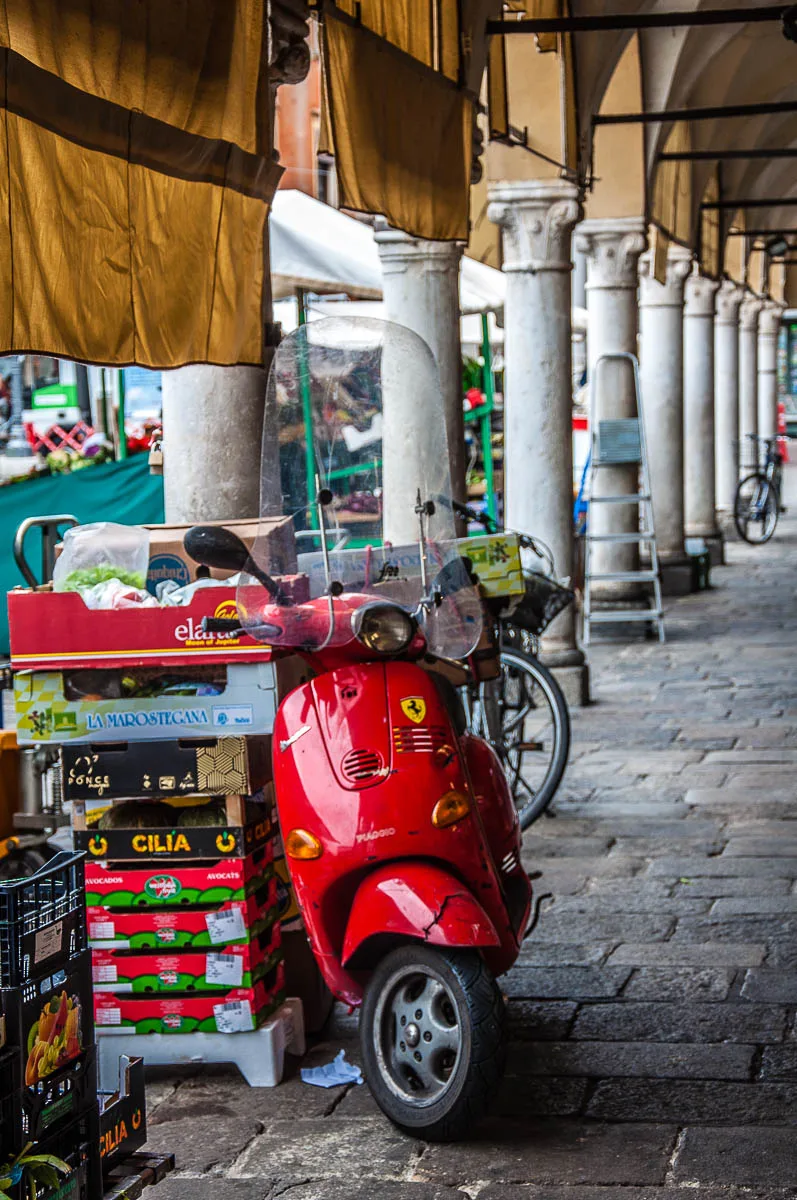
If it starts to rain or if the sun shines too bright, take refuge under the porticoes of Padua. In a word, these are pavements with a ceiling above them. Padua is one of the three cities in Italy and coincidentally the world (the other two being Bologna and Turin) with the longest in terms of km total length of porticoes.
The tradition of building porticoes in Padua is ancient. There are porticoes of many different eras and styles here: Romanesque, Gothic, Renaissance, Neoclassical and even many contemporary ones. You can easily walk all over Padua’s historical centre barely leaving the protective shade of its porticoes.
IV. Facts About Interesting Museums in Padua, Italy
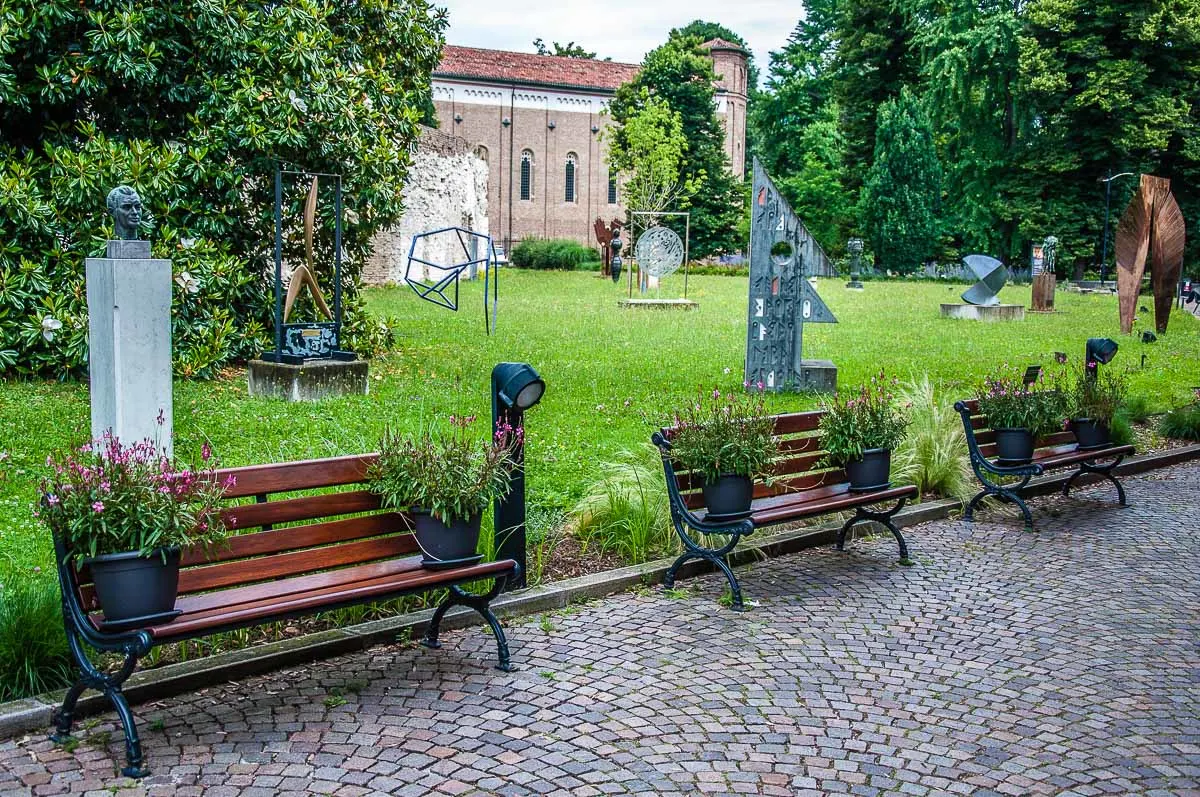
Padua, Italy is home to many exciting museums and galleries both in and outside the city’s historical centre. You will be spoilt for choice and can easily fill up several days with museum visits and world-famous masterpieces during your stay in Padua.
Set time aside to explore in detail the Eremitani Civic Museums. Their rich collections are split between the Archaeological Museum and the Museum of Medieval and Modern Art. They are housed in the old cloisters of the Eremitani Monastery on the edge of Padua’s historic centre. The world-famous Scrovegni Chapel is also part of this splendid museum complex.
Across the street from the Eremitani Civic Museums, you will find Palazzo Zuckermann – the seat of the Museum of Applied and Decorative Arts and the Bottacin Museum. Nicola Bottacin, a rich merchant, bestowed his art and numismatic collections to the city of Padua in 1865. Expect beautiful and refined jewellery, ceramics, furniture, and medals. The best thing is that the ticket for the Eremitani Civic Museums also includes entry to the museums in Palazzo Zuckermann.
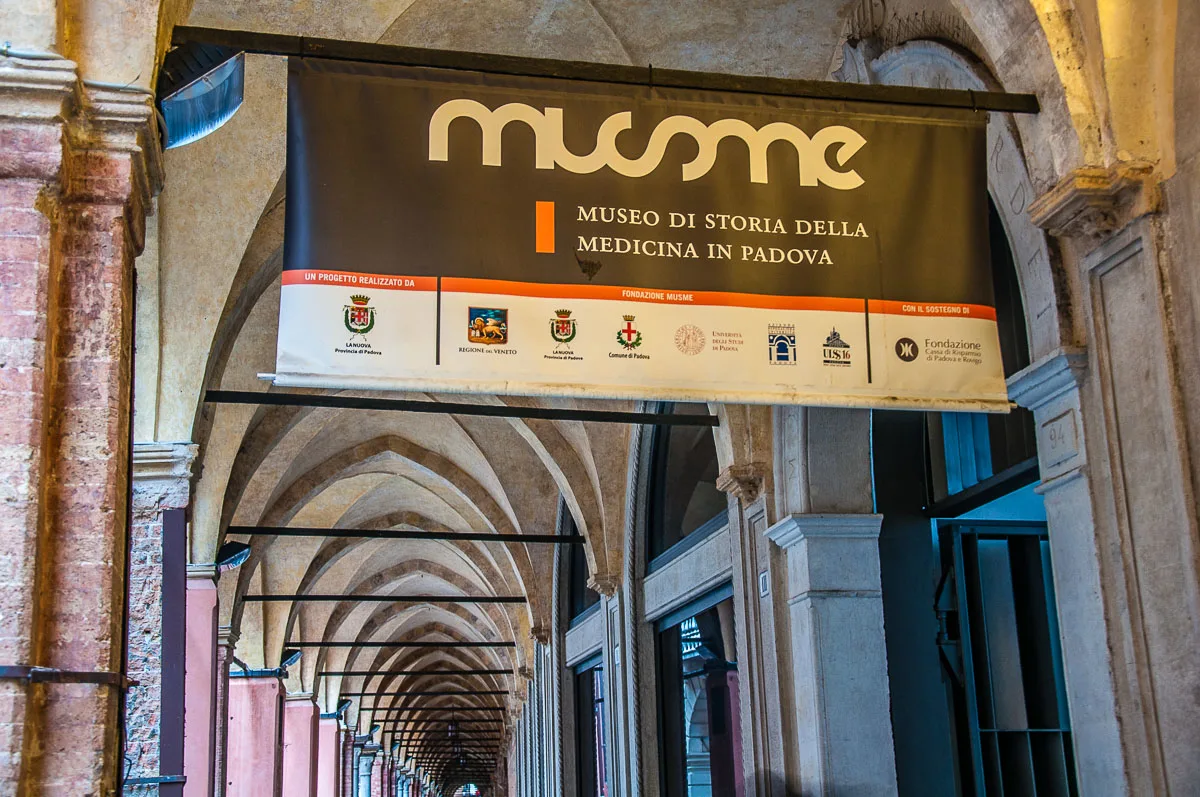
MUSME is an innovative museum dedicated to the history of medicine from ancient to our modern times. A special emphasis is placed on the history of Padua’s Medical School. The museum is in a 15th-century building that for almost four centuries served as Padua’s hospital. Interactive and multimedia exhibits and itineraries explore the human anatomy, physiology, pathology and therapeutics among other things.
Padua’s historic coffee house – Caffe’ Pedrocchi – houses a museum, too. On its piano nobile you will find the Museum of Risorgimento and the Contemporary Age. It documents the events of a tumultuous for the Veneto century and a half – from the fall of the Venetian Republic in 1797 to 1st January 1948 (the day on which the Italian Constitution came into force).
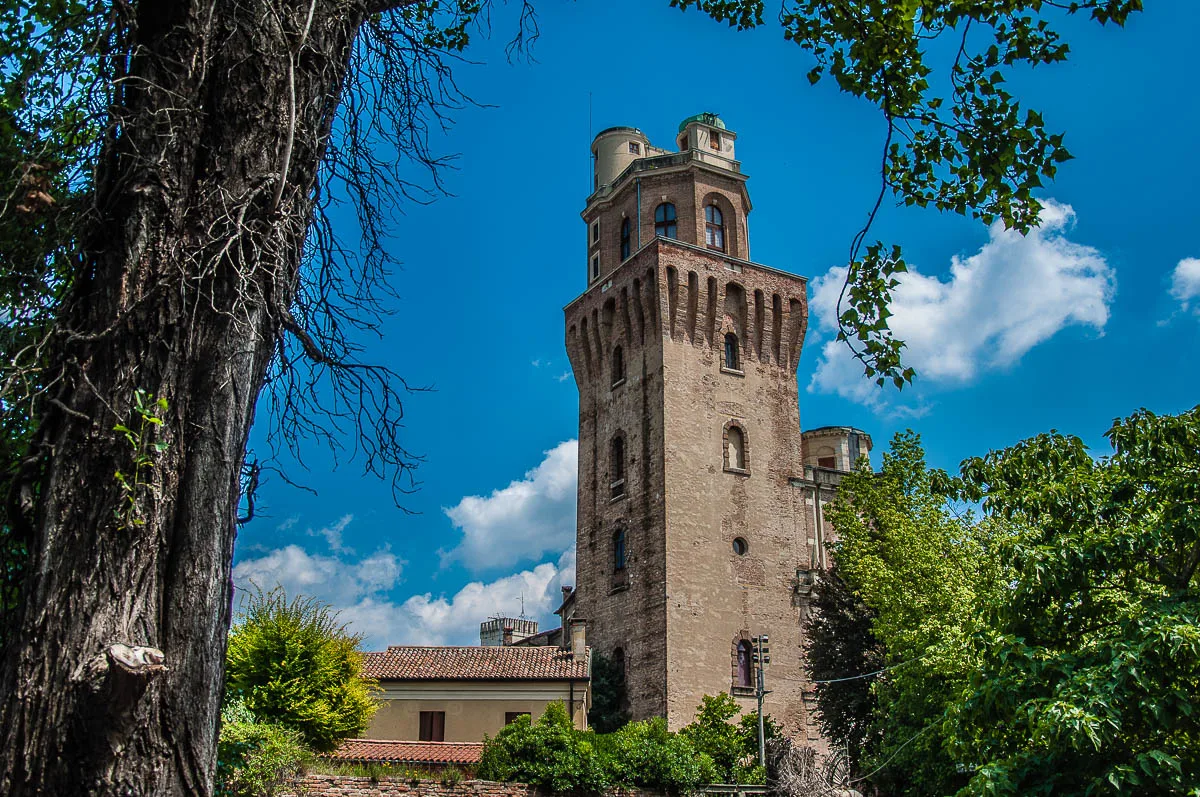
The Museum of the Astronomical Observatory of Padua – La Specola – is housed in the medieval tower La Torlonga. There you can see the lower observatory in the Meridian Hall and the upper observatory at 35 m height in the Hall of Figures. 18th-century instruments made by English craftsmen and used by Paduan astronomers are also on display here. In the past, La Torlonga was part of the Castle of Padua – a medieval defensive structure. The tower was turned into an astronomical observatory in 1761.
If you love looking at the stars, head over to the Planetarium on the outskirts of Padua, Italy. With daily events, some of which in English, it is a great place to learn about astronomy and the sky.
If shoes are your passion, don’t miss Il Museo della Calzatura. You will find it in Stra – a small riverside town within a very short distance from Padua. Housed in the splendid Villa Foscarini Rossi, the museum has two permanent exhibitions and hundreds of pairs of exquisite shoes. Next door to it is the splendid Villa Pisani. It is known as the Queen of the Venetian Villas and it’s a must-see.
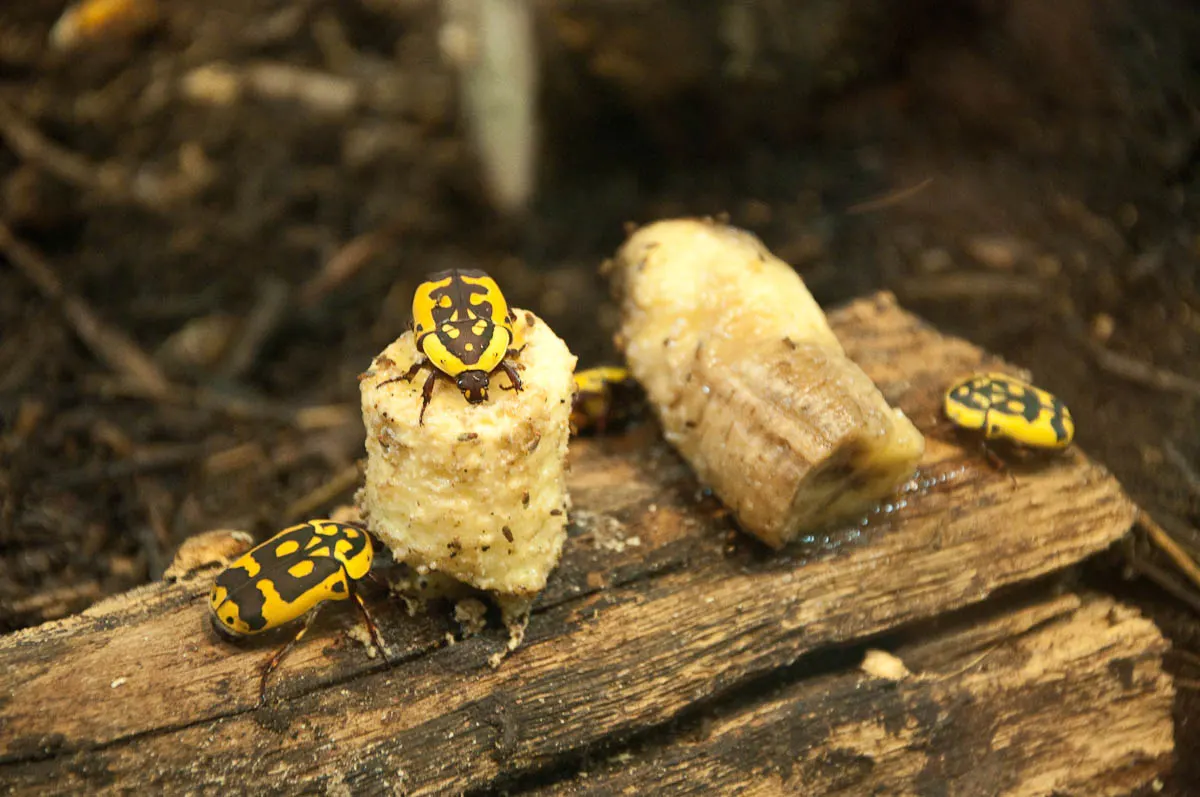
Esapolis – The Museum of Living Insects is a great destination if you are visiting Padua with kids. The museum has a large collection of insects from all over the world. They live in glass displays replicating their natural environment. Click here to read more about it.
Kids will love the chance to explore the Museo Veneto del Giocattolo, too. Established in 2006, it has a large collection of toys and games from the 19th century up to the 1970’s. There are seven different sections and a special wing dedicated to toys produced by a local to Padua famous Italian toy company.
V. Facts About Important Churches and Religious Sights in Padua, Italy
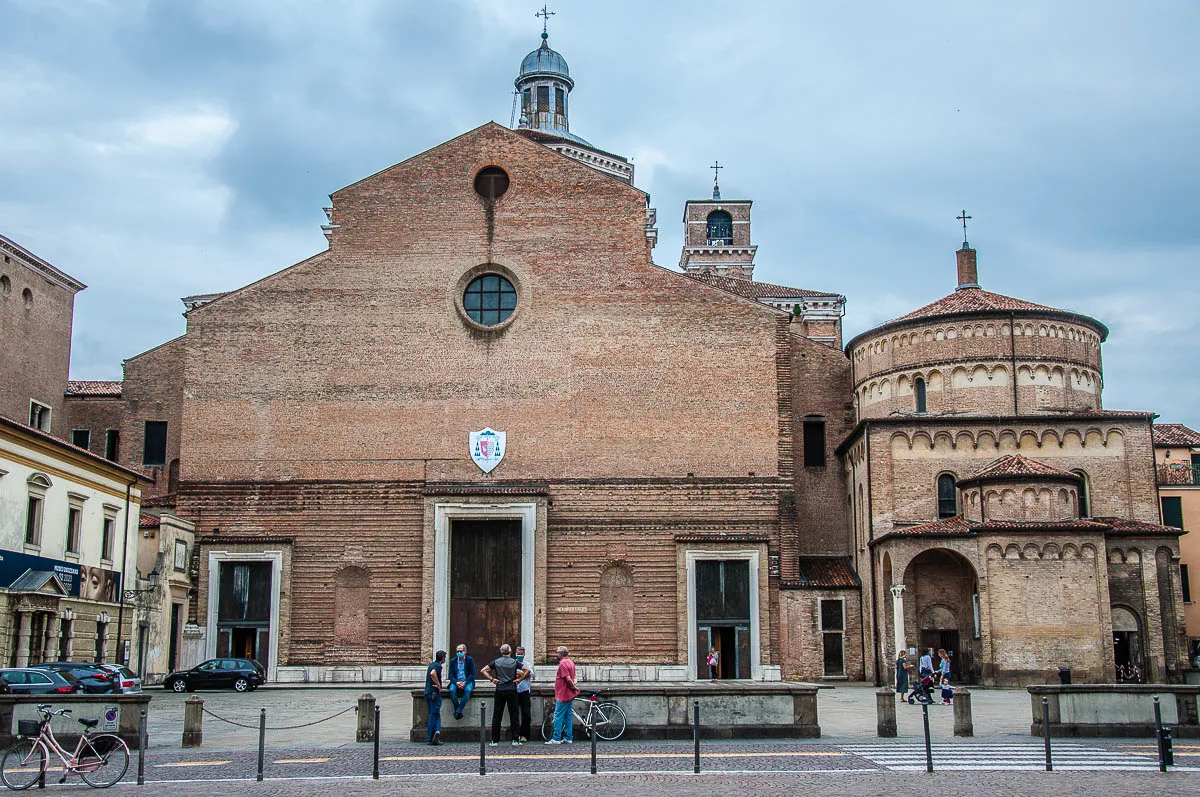
The 16th-century Cathedral of Santa Maria Assunta at Piazza Duomo is the seat of the Bishop of Padua. While it looks quite bare and unfinished, some experts claim that the famous sculptor and artist Michelangelo contributed to the design of the Padua Cathedral.
Padua Baptistery is right next door to Padua Cathedral. It’s a must-see sight in Padua for its interior is completely covered with 14th-century frescoes by Giusto de Menabuoi. Stand in the middle of the Baptistery and lift your eyes up. Meeting the gaze of the dozens of saints and angels surrounding Christ Pantocrator in the centre of the dome is a hypnotic experience.
On the other side of Padua Cathedral stands the city’s Diocesan Museum. Housed in the 15th-century residence of the Bishops of Padua, it has a lovely collection of works of art. The Bishops’ Hall here has a particularly stunning fresco cycle. It depicts the first 100 Bishops of Padua starting with St. Prosdocimus who first introduced the Christianity to Padua. The frescoes were originally painted by the Renaissance artist Bartolomeo Montagna.
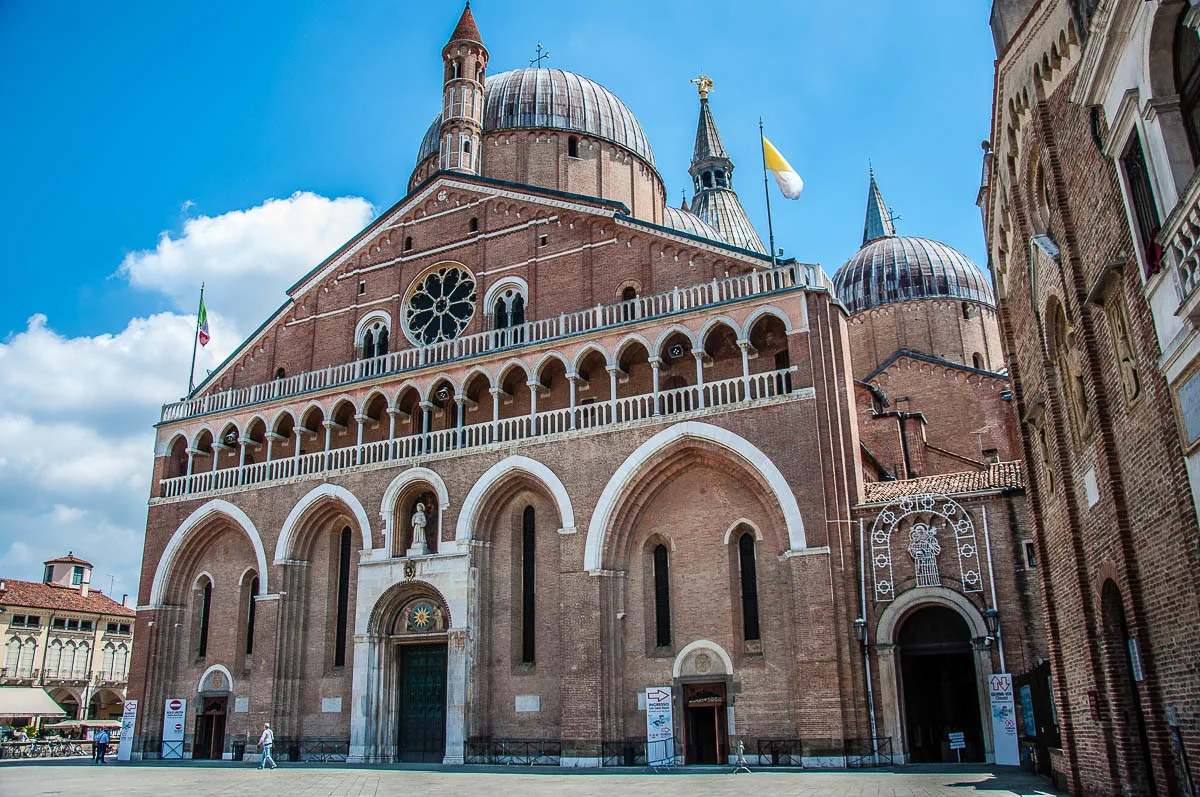
The Basilica of St. Anthony is the most important religious sight in Padua. Over six and a half million pilgrims visit it every year. Originally, it was built between 1232 and 1310 and then it was modified several times throughout the centuries.
With its architectural mix, splendid frescoes and treasure trove of masterpieces, the Basilica is a must-see. I particularly love the fresco showing St. Anthony’s Sermon to the fishes. The Basilica’s cloisters are a quiet place of reflection. The Basilica’s Museums have a rich collection of art and trace the life of St. Anthony. There you can also see the votive offerings made in gratitude for graces received through the intercession of the Saint.
St. Anthony is entombed in the splendid Chapel of St. Anthony inside the Basilica.
His tongue, his vocal apparatus, and his jawbone are kept separately in the Chapel of the Relics (also called Treasure Chapel) in the Basilica. In 1263 (32 years after the death of the Saint) his remains were moved to the Basilica the construction of which had began one year after the Saint’s passing. While the body of St. Anthony had succumbed to decomposition, his tongue was, quite miraculously, untouched.
Nowadays, the Incorrupt Tongue of St. Anthony is kept in a crystal reliquary made in 1436 by the goldsmith Giuliano da Firenze. Another reliquary from 1350 contains the Saint’s jawbone. A third reliquary (created by C. Balljana in 1981) contains the Saint’s vocal apparatus which was removed during the last scientific examination. A fourth reliquary (created by R. Cremesini in 1982) contains a bone from the foot, a fragment of skin and some hair from the body of St. Anthony.
The Chapel of the Relics also holds a silver case with a fragment of the True Cross.
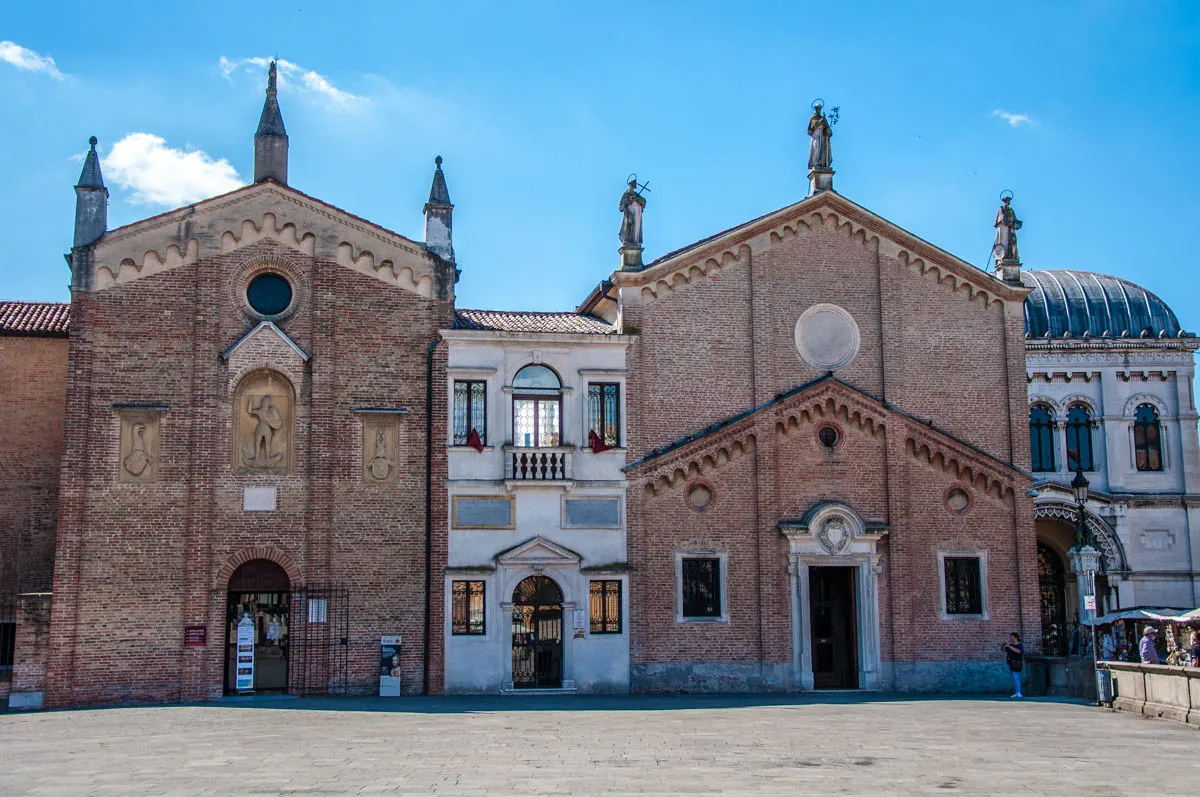
Next door to the Basilica of St. Anthony of Padua, don’t miss the Oratory of San Giorgio and the Scuola del Santo. The Oratory has a magnificent 14th-century fresco cycle by Altichiero da Zevio – a follower of Giotto. The Scuola has a series of 18 frescoes from the beginning of the 16th century. Three of them were painted by Titian – one of the most famous artists of the Venetian School.
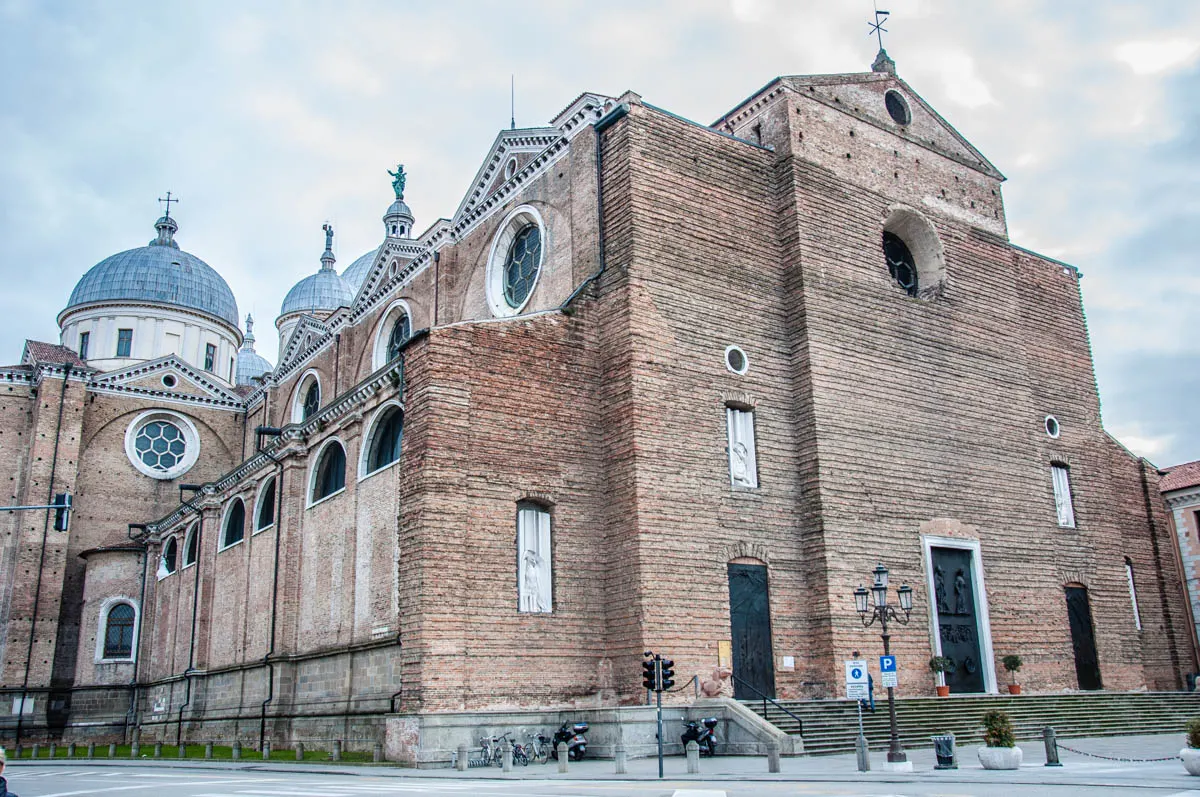
The Basilica and Abbey of Santa Giustina is another must-see church in Padua, Italy. 118.5 m long and 82 m wide, it is Italy’s seventh-largest church based on its area. It stands right by Prato della Valle. Initially built in the 6th century, the Basilica had a tumultuous history having been both sacked by troops and devastated by an earthquake. Its present building took shape in the 17th century.
The Basilica and Abbey of Santa Giustina is where you can see the tomb of St. Prosdocimus – the first Bishop of Padua. In the 1st century AD, he introduced Christianity to Padua and the Veneto. He was sent there from the Ancient Greek city of Antioch by St. Peter the Apostle.
St. Justina (Santa Giustina in Italian) – one of the first Christian martyrs – is also buried in the Basilica and Abbey of Santa Giustina. She is the patron saint of Padua and the second patron of Venice after St. Mark. In the Paduan basilica dedicated to her, you can see The Martyrdom of St. Justina by the famous Renaissance painter Paolo Veronese.
There are many historic churches all over Padua. Many of them have priceless frescoes, unique works of art, and captivating history. Visiting every church that you come across during your explorations of the city is a great way to learn about Padua in particular and Italy as a whole.
VI. Facts About the Jewish Heritage of Padua, Italy

Padua’s historic Jewish Ghetto is an important part of the city’s past. You will find it in the heart of the historic centre, just a few steps away from Piazza delle Erbe. Its narrow cobbled streets nowadays are lined up with small boutiques and chic eateries.
There has been a continuous Jewish presence in Padua, Italy since the 11th century. A well-curated Jewish Heritage Museum offers an in-depth overview of the lives of the Jewish people in Padua over hundreds of years.
The visit to the Jewish Heritage Museum also includes a visit to the nearby synagogue. Originally built in 1548, it is the only one still functioning in Padua. The 16th-century Torah Ark here is made from the wood of a tree that was struck by lightning in the University of Padua Botanical Garden.
Once a month you can also join a guided visit to a Jewish cemetery in Padua, Italy. It has been used since the 16th century and until the 18th century, it was outside the city’s medieval walls.
Rabbi Meir Katzenellenbogen is buried here. He was born in Prague in 1565 and died in Padua in 1565. His tomb and that of his son Samuel attract pilgrims from all over Europe.
VII. Facts About Important Personalities with a Strong Connection to Padua, Italy
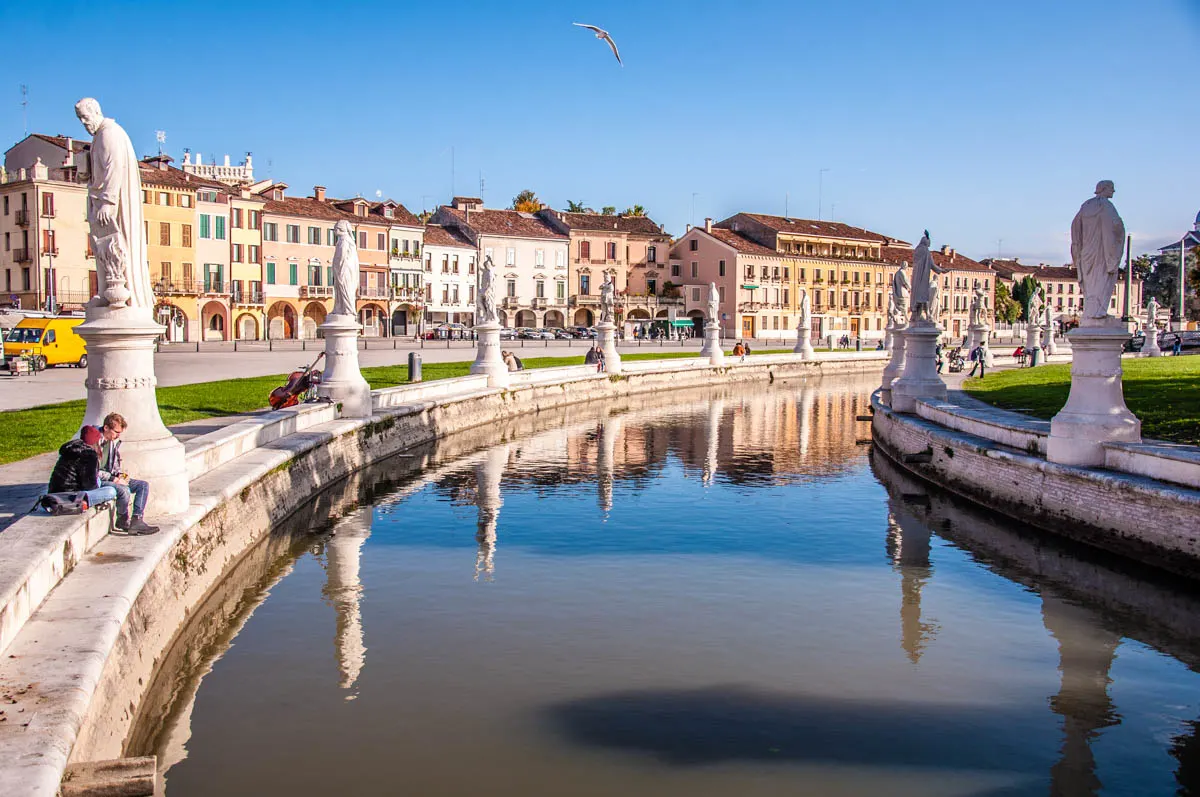
For a great overview of Padua’s most famous personalities, head to Prato della Valle. This enormous square is surrounded by an elliptical canal on the edges of which stand 78 statues. Each represents a person who left his indelible mark on the city. For example, Petrarch is statue number 35 and Galileo Galilei is statue number 36.
Padua’s academic environment and free spirit attracted many illustrious men and women to the city throughout the centuries. In addition, several important personalities were born here. Below are only some of these scientists, artists, inventors, and writers, many of whom nowadays are famous all over the world.
One of the most celebrated Roman historians was born and died in Patavium (nowadays Padua in Italy). His name is Titus Livius and he is known as Livy in English. He was extremely proud of his home city and its conservative values. Between the 1st century BC and the 1st century AD, Livy wrote an exhaustive history of Rome and its people. His bones are kept in an urn on Prato della Valle.
Another famous son of Patavium was the Roman senator P. Clodius Thrasea Paetus. As an opponent of immorality, Paetus disagreed with Emperor Nero’s plans to kill his own mother, which led to Paetus’ death in 66 AD.
The great poet and humanist Petrarch was not born in Padua but he found a warm welcome in the city. He lived in Padua during its biggest cultural bloom under the rule of the Carrara family in the 14th century. Petrarch even wrote the epitaph for one of the Carraresi (you can see it carved on marble in the Church of the Eremitani). Petrarch then retreated to the small village of Arqua’ Petrarca in the Euganean Hills near Padua. He spent the last five years of his life there and his tomb stands in front of the village’s main church to this day.

The renowned Renaissance sculptor Donatello spent ten years of his life in Padua. Here he created several sculptures and bas-reliefs for the altar of the Basilica of St. Anthony. Donatello also cast out of bronze the first full-size equestrian monument since the Antiquity. Depicting the military leader Gattamelata, you can see it in front of the Basilica in Padua. Opposite the Basilica stands the house in which Donatello lived during his time in the city. A large sign testifying to it is affixed to the facade of the house.
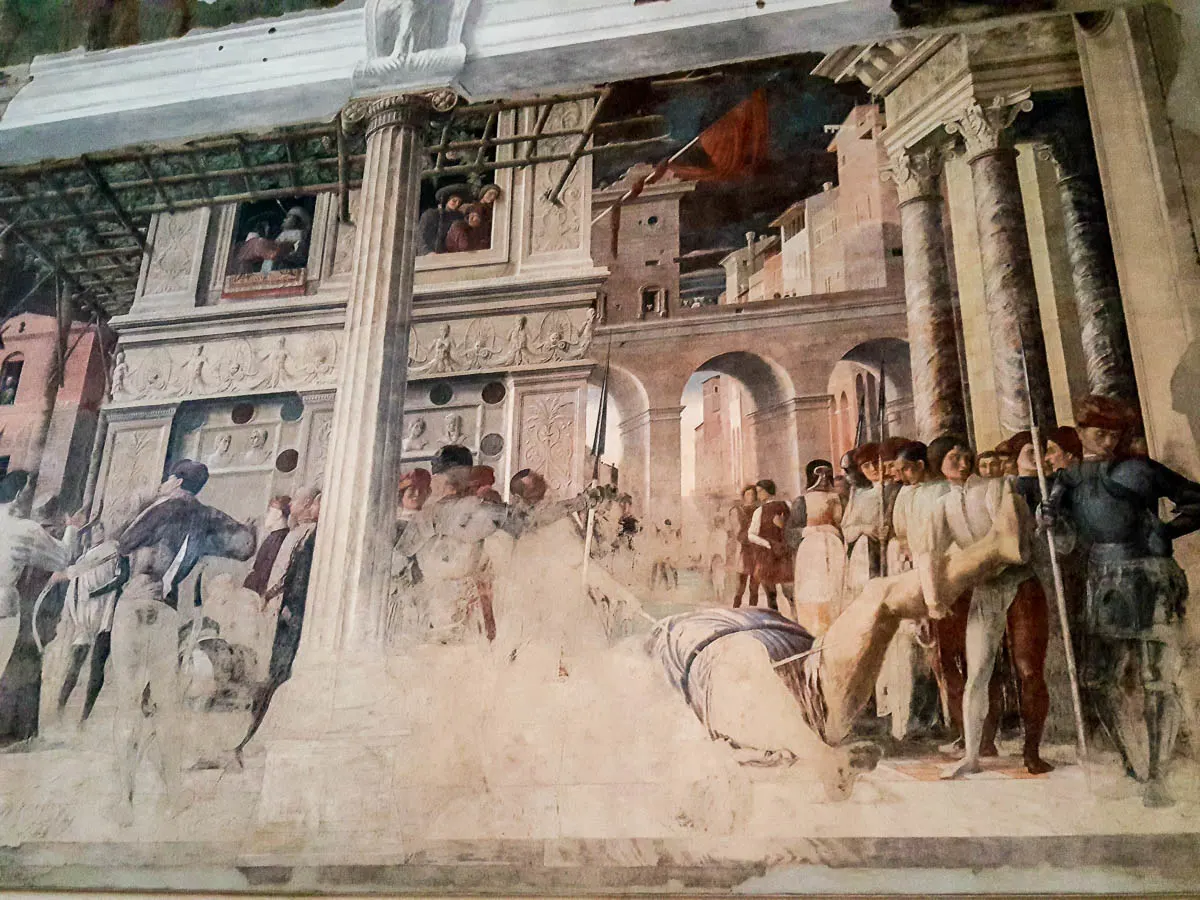
The great Renaissance painter Andrea Mantegna was born in a village close to Padua in 1431. He apprenticed under the Paduan painter Francesco Squarcione and became famous for painting chiseled monumental figures that look like sculptures on canvas. In Padua’s Church of the Eremitani you can see one of Mantegna’s most famous works – a fresco cycle which was destroyed during the Second World War. Click here to find out how the frescoes were brought back to life with the help of a specially created piece of software.
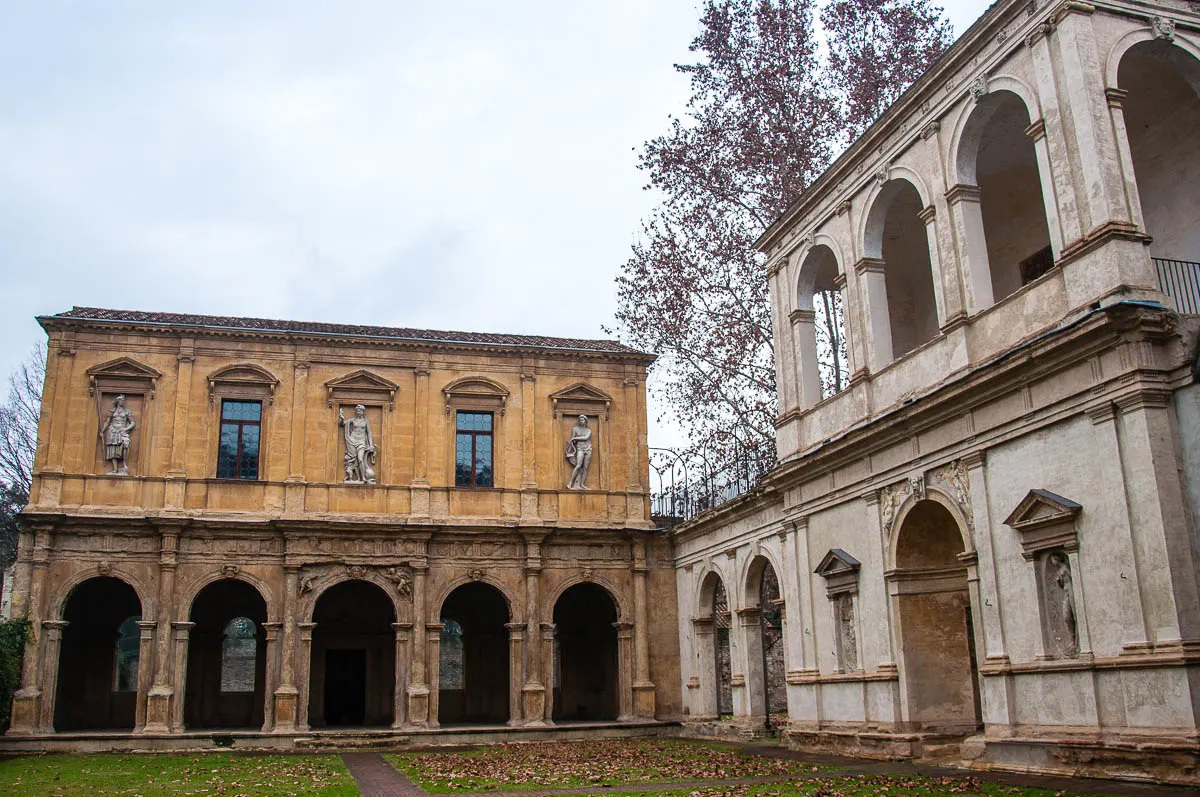
A Veronese architect and painter called Giovanni Maria Falconetto introduced Renaissance architecture to Padua and completed several projects in the city. The 16th-century Cornaro Loggia and Odeon in Padua, Italy were designed by Falconetto and were the first fully Renaissance buildings in the Veneto. Read more about them here.
Andrea Palladio was born in Padua in 1508. Nowadays he is recognised as one of the most influential architects in the world for the past 500 years. You can see a humble plaque on the wall of his birth house on Via dei Rogati in the historical centre of the city. It’s an established fact that Palladio was a frequent visitor to the Cornaro Loggia and Odeon in Padua. The buildings and the theatrical performances that were staged there were among his inspirations for the world-famous Teatro Olimpico in nearby Vicenza.
Gaspara Stampa is another celebrated Paduan. Born in 1523, she is considered the greatest woman poet of the Italian Renaissance. Stampa wrote 311 poems, most of which were dedicated to a Venetian count she was in love with. Her poetry was inspired by her feelings of elation and depression brought to her by love.
Galileo Galilei spent 18 years (1592-1610) living and teaching in Padua. In his own words, that was the happiest period of his life. At Palazzo Bo – the historic seat of the University of Padua – you can see the Aula Magna where Galilei used to hold his lectures, as well as the podium on which he used to stand. Another curious artefact here is Galileo’s own vertebrae. It’s held in a special stand just across the room from the great scientist’s podium.
You can also see (only from the outside) the house in which Galilei resided during some of his 18 years in Padua. There are brown signs pointing you to it as you walk around the historic centre. The house is on Via Galilei and it is marked with a humble plaque. It is incredible to think that the scientist discovered the four largest moons of Jupiter during astronomical observations with his telescope conducted in the garden of this house.
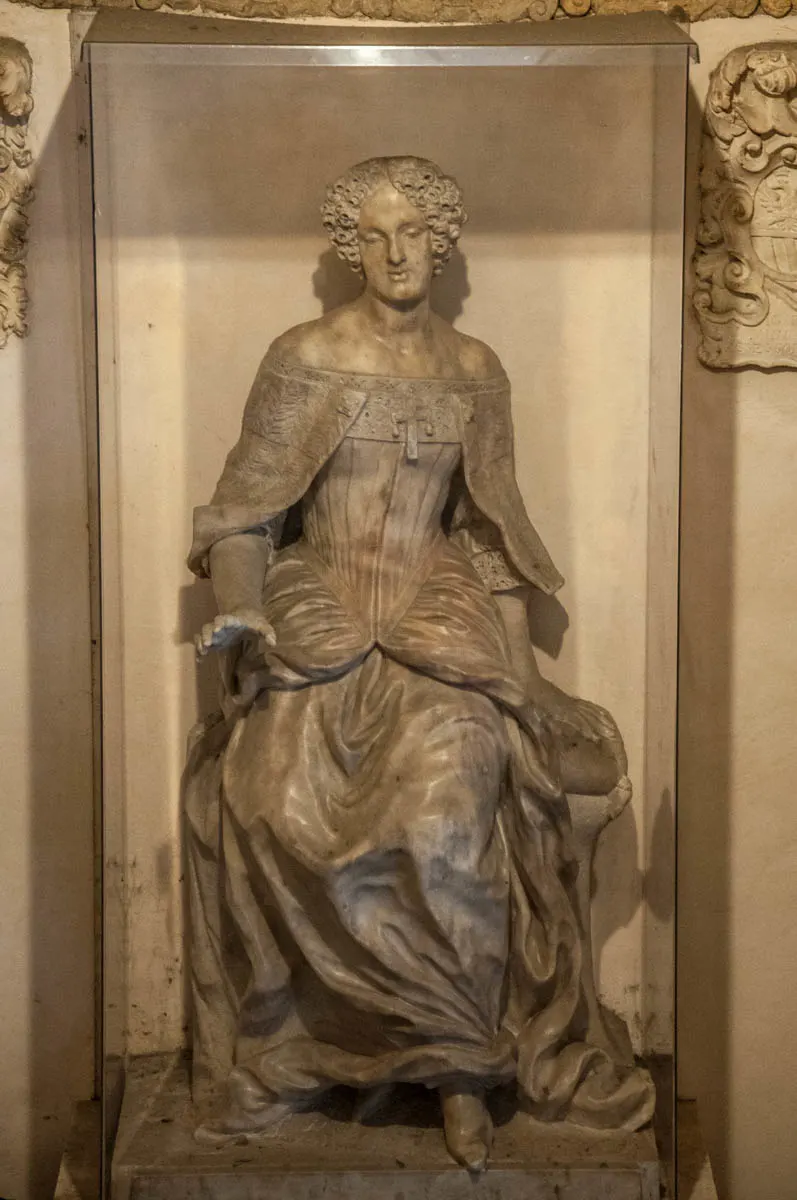
The University of Padua was the first University in the world to give an academic degree to a woman. The Venetian Elena Cornaro Piscopia was awarded her PhD in philosophy on 25th June 1678. She originally wanted to complete a degree in theology but was not allowed on the base that she was a woman. Nowadays, you can see Elena’s statue in Palazzo Bo – the historic seat of the University of Padua. Her tomb is in the Basilica of Santa Giustina right next to the expansive square Prato della Valle.
The inventor of the piano – Bartolomeo Cristofori – was born in Padua in 1655. Three of the pianos personally made by him survive to this day and are kept in New York, Rome, and Leipzig.
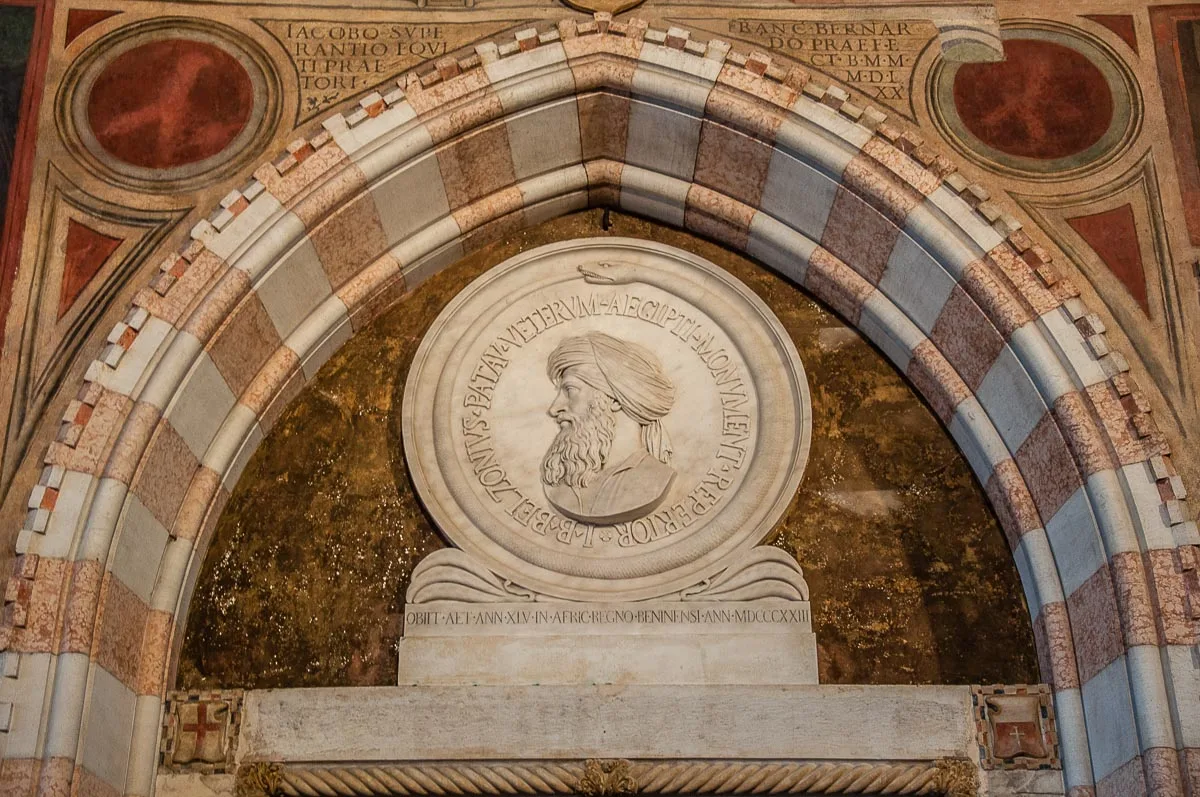
The pioneer archaeologist Giovanni Battista Belzoni was born in Padua in 1778. He was one of the first Europeans to explore Egypt where he discovered important Ancient Egyptian sights. A special medallion in Padua’s Palazzo della Ragione commemorates Belzoni’s life and achievements. In the Egyptian rooms of the Eremitani Civic Museums you can see some of the artefacts from Belzoni’s own collection.
VIII. Facts About Celebrations and Events in Padua, Italy
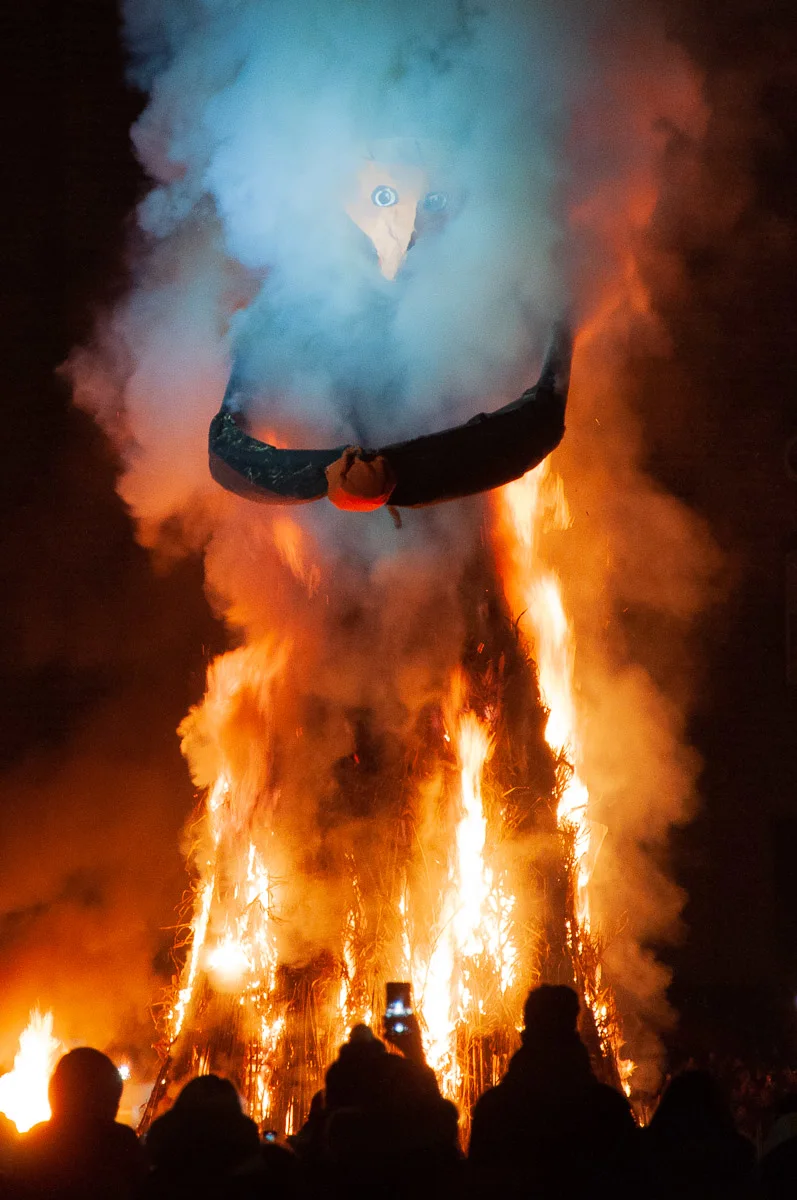
Padua is a lively city with a calendar rich in events, festivals, and traditional celebrations.
On 6th January every year, the city celebrates Epiphany by setting on fire a large effigy of Befana. She is the old lady who brings presents to the well-behaved Italian children on the night of the 5th to the 6th of January. Burning her effigy is a rite popular in many corners of Italy. It symbolises leaving the old year behind and starting anew. In Padua, head to the expansive Prato della Valle in the evening of the 6th January to see it happening. Locally, it’s known as Il Falo’ della Befana and it’s a great experience.
13th June – the Day of St. Anthony – is a special day for Padua, Italy. A large procession carrying the relics and the statue of the saint takes to the streets of the city. A mass is served at the Basilica of St. Anthony hourly.
On 15th February each year, Padua celebrates the Festa della Lingua. This is an occasion for believers to mark the miracle that preserved the tongue of St. Anthony.
To check what events will be on during your time in Padua, Italy, keep an eye on the websites of Gran Teatro Geox and Fiera di Padova. These are the two large venues where concerts, performances, festivals, and exhibitions take place regularly throughout the year. When you arrive in Padua, you can get leaflets and brochures for upcoming events from the official tourist information offices, too. One is inside the Padua’s train station and another is in the portico right behind Caffe’ Pedrocchi.
IX. Facts About Food in Padua, Italy
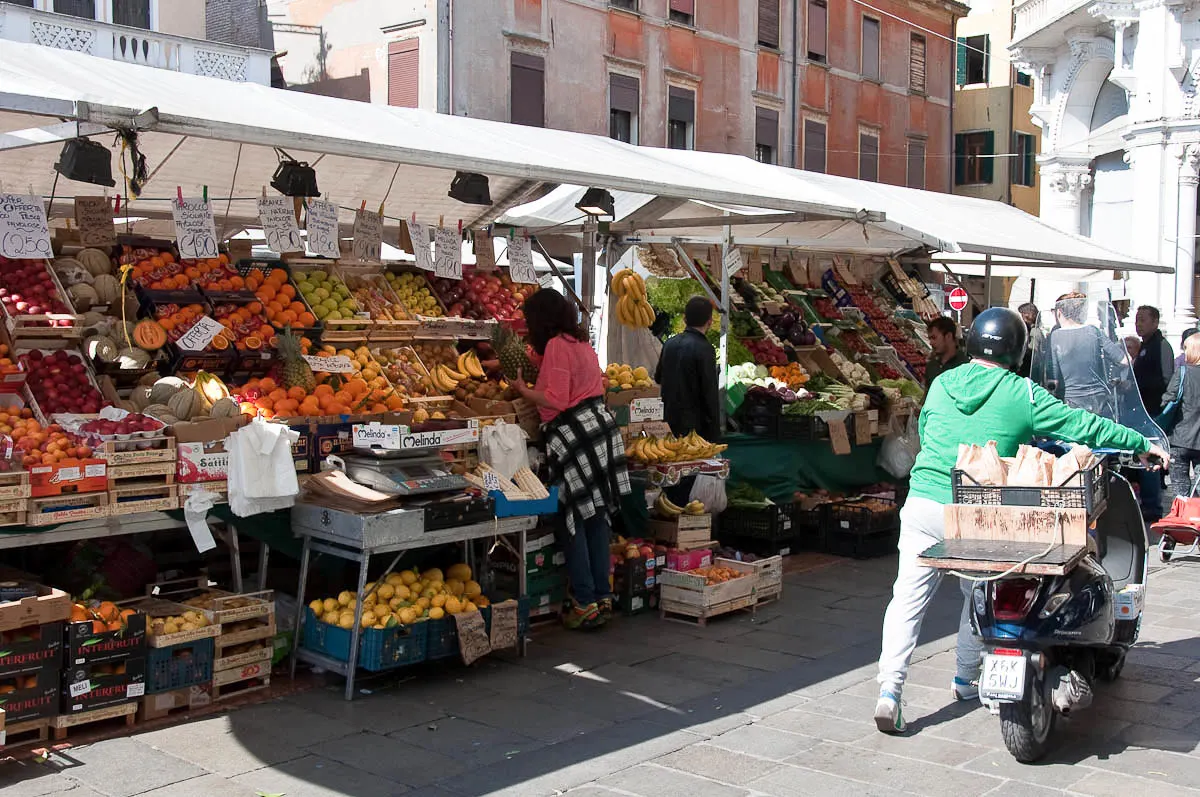
Padua has a fresh produce market that is 800 years old! For the past eight centuries, it has been held at the same spot – the historic squares Piazza delle Erbe and Piazza della Frutta which flank the imposing medieval town hall Palazzo della Ragione. The market opens early every day (Sundays excluded) and it closes just after midday. Click here to find out more details.
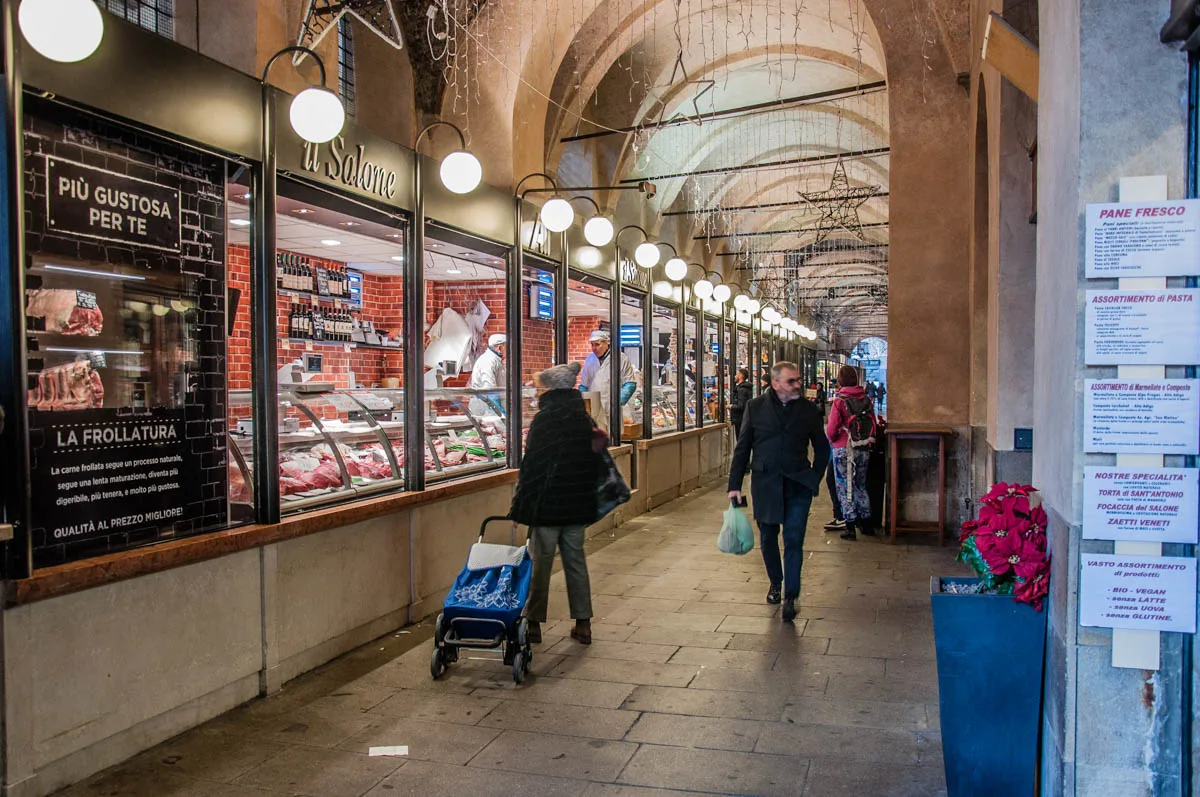
At the same time, the ground floor of Palazzo della Ragione (which is right between the two squares mentioned above) houses some of the best butchers, fishmongers, delis, bakeries, and eateries in Padua. Known as Sotto Il Salone, the citizens of Padua consider it to be the oldest covered shopping mall in the world. Here you can buy zero km food, see pasta being made on-site, and choose from a large variety of Italian salumi and cheeses. Delicious vegan food is sold here, too.
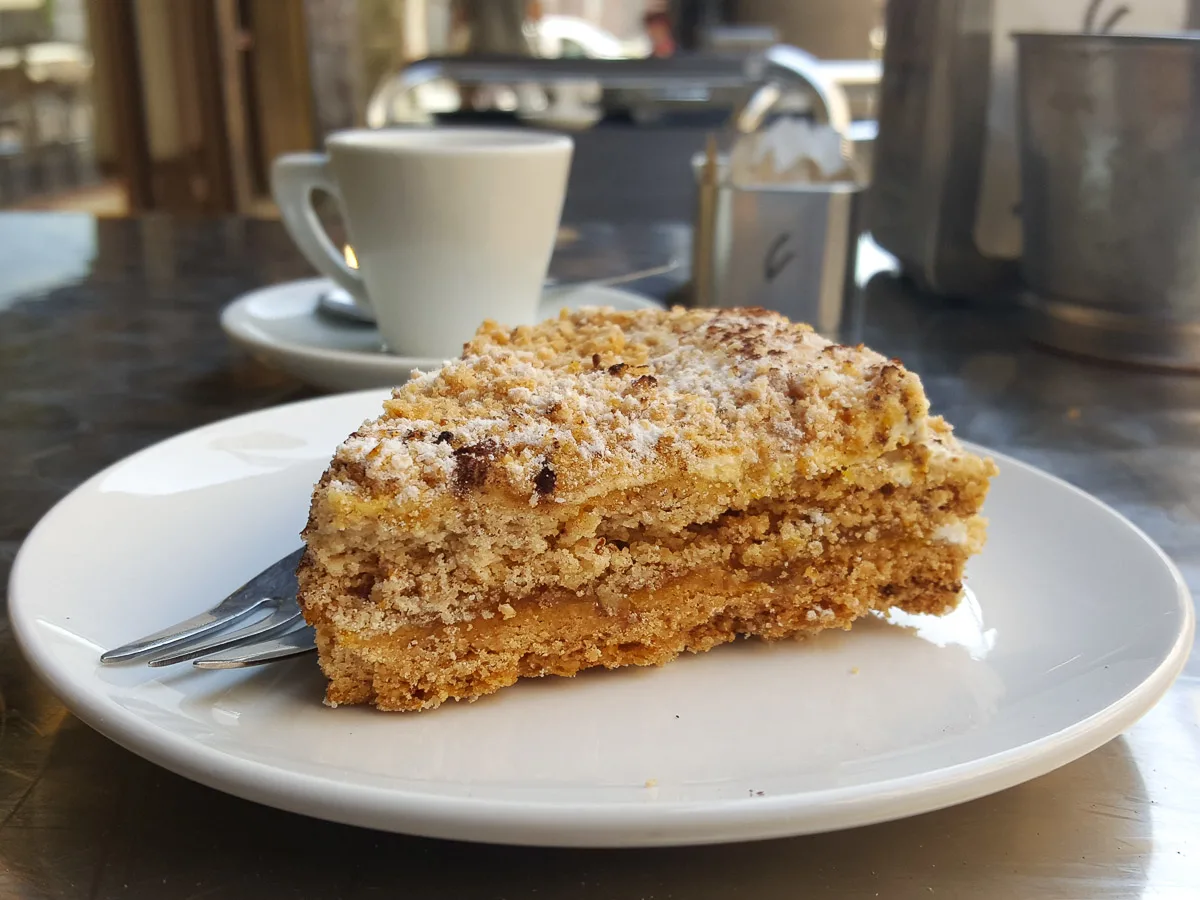
Padua has some of the best cakes, sweets, and biscuits this side of Italy. The local Torta Pazientina is particularly famous. This is a multilayered cake the origins of which can be traced back to the 16th century. It has an almond paste base, two layers of zabaglione, and a layer of sponge cake.
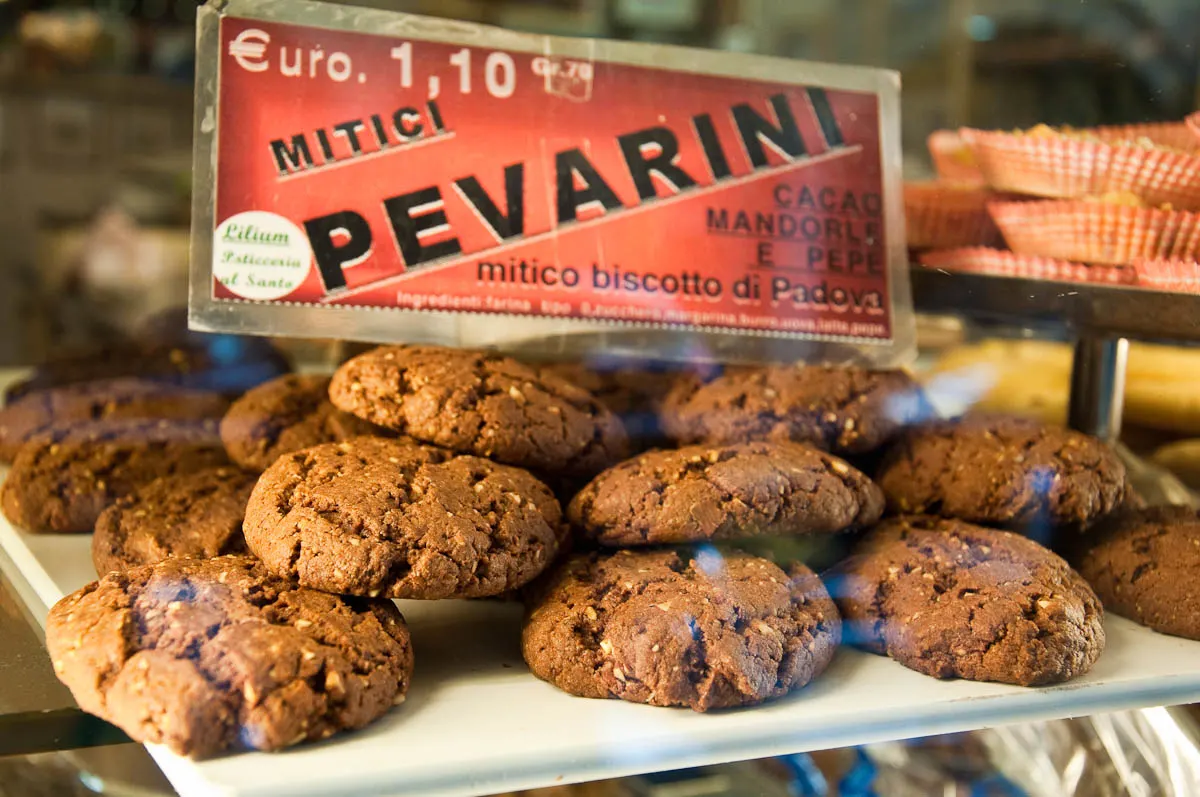
Here are a few more must-try local delicacies: zaeti (traditional cornmeal biscuits scented with oranges and studded with raisins), crostoli (thin crumbly sheets of fried dough typical for the Carnival period), fregolotta cake (quite similar to the Scottish shortbread), huge meringues in pastel colours, and pevarini biscuits (made with cacao, almonds and then spiced with black pepper).
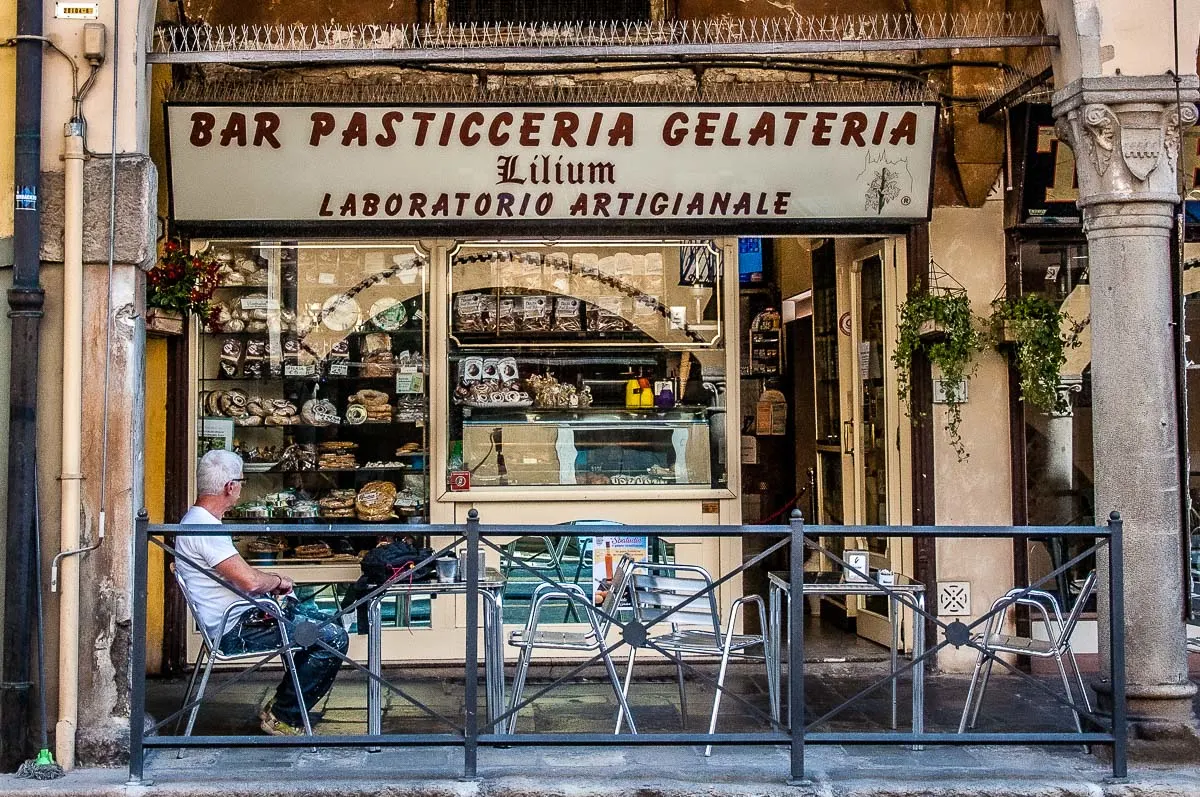
Bar Pasticceria Lilium is an artisan cake shop in Padua making and selling all of the above traditional biscuits and sweets. You will find it near the Basilica of St. Anthony.
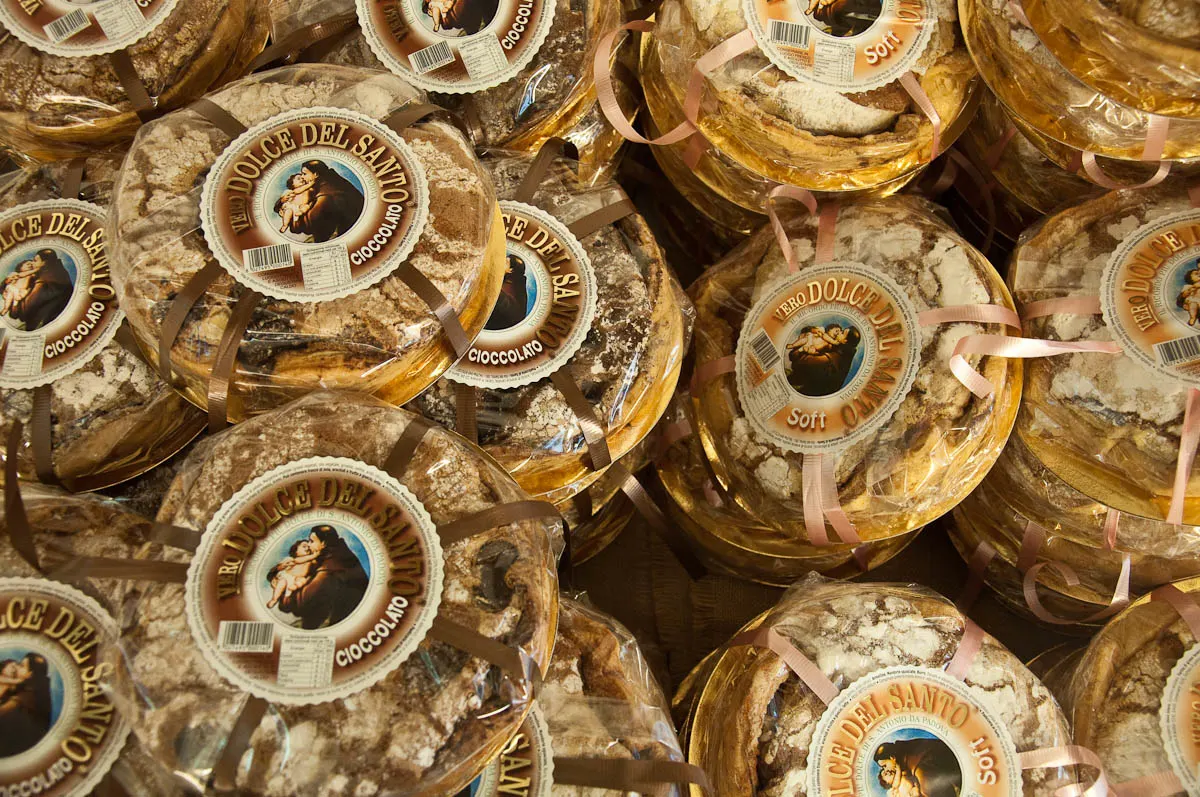
Bar Pasticceria Lilium is also where they make the very popular Dolce del Santo (the Cake of the Saint). This is a puff pastry-based cake with a layer of sponge and a helping of apricot jam. Click here to find out more about it and what’s its connection to St. Anthony – Padua’s patron saint.
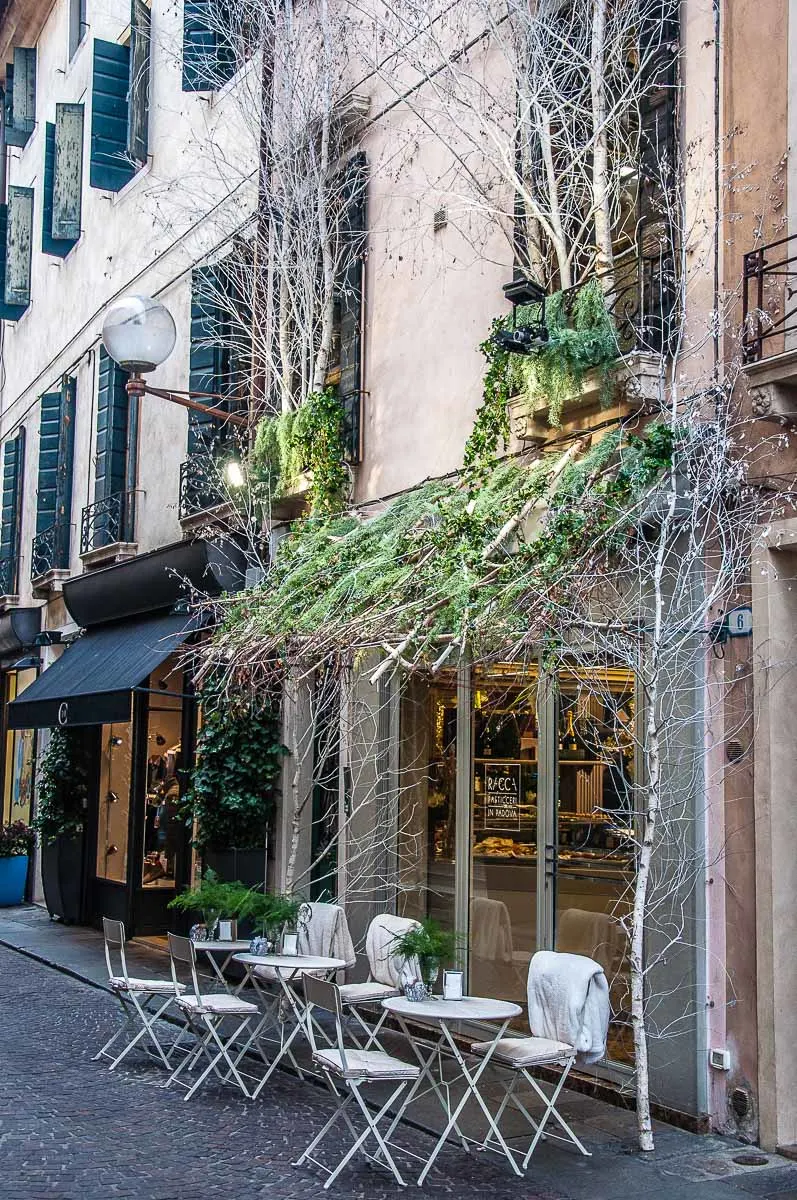
Padua has many fabulous cafes, patisseries, and gelaterias. Dozens of them line the city’s streets. One of my favourites is Pasticceria Racca with its delicious bite-size cakes and lavish seasonal decorations and displays.
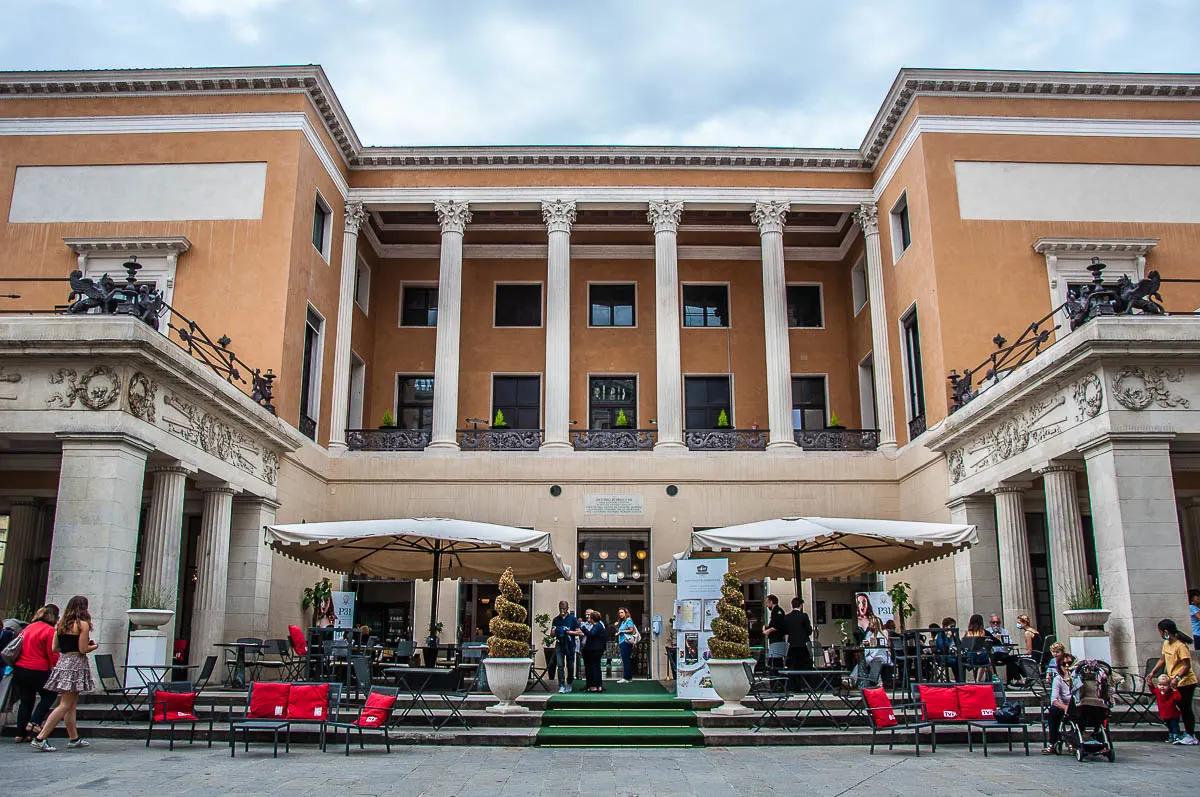
Caffe Pedrocchi is Padua’s most legendary cafe. Founded in 1772, it is one of Italy’s oldest coffee houses, too. They used to call it ‘the cafe without doors’ as from 1831 (year of construction of its current grand premises) to 1916 it was open 24 hours and its doors were never closed. You will find Caffe Pedrocchi right opposite Palazzo Bo (the historical seat of the University of Padua).
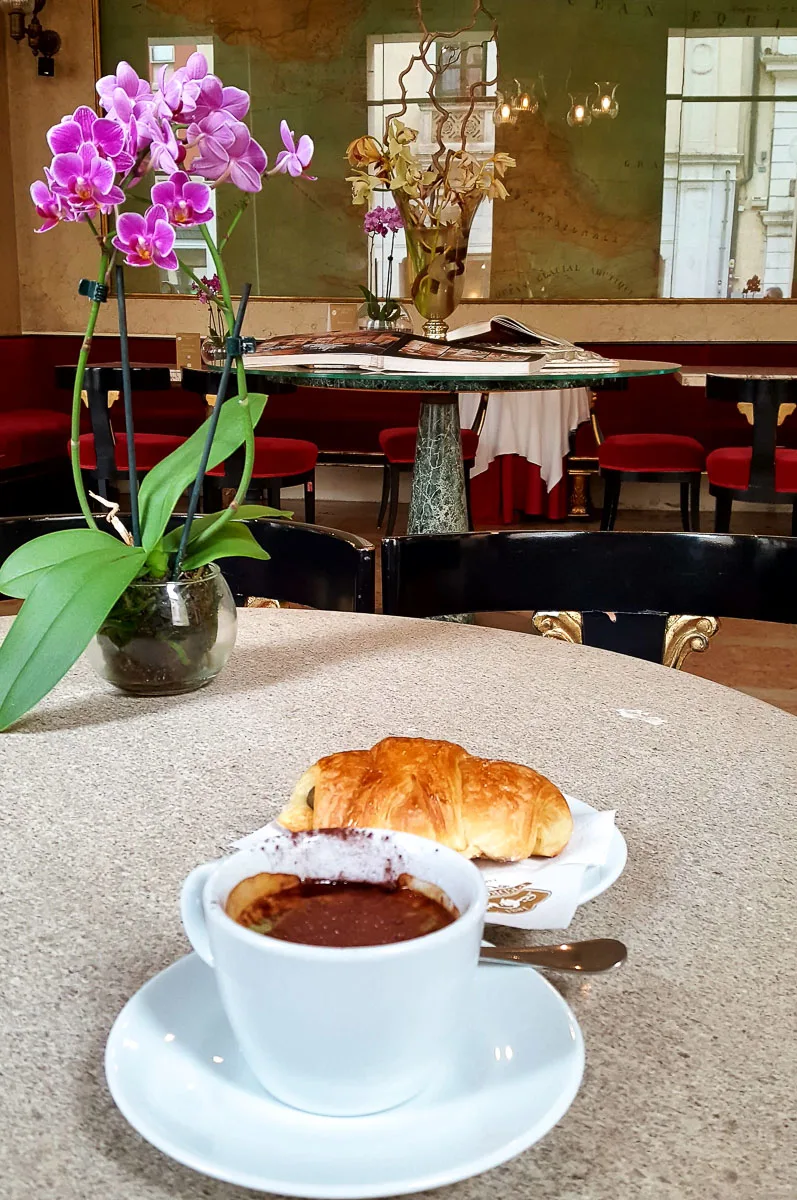
The signature coffee of Caffe Pedrocchi is also called Pedrocchi. It’s a strong espresso layered with mint emulsion, cream, and bitter cocoa powder. It’s delicious! If you order one then take it in tiny sips so as to taste all ingredients together all the way through.
Antica Drogheria Caberlotto is a good shop to head to in Padua if you want to stock on regional delicacies from all over Italy. Here you can also find the very popular fregolotta cake, plus some rare for Italy goodies like proper English tea and Scottish shortbread. The shop is in the porticoes opposite Palazzo della Ragione in Padua’s historic centre.
X. Facts About Modern-Day Padua, Italy
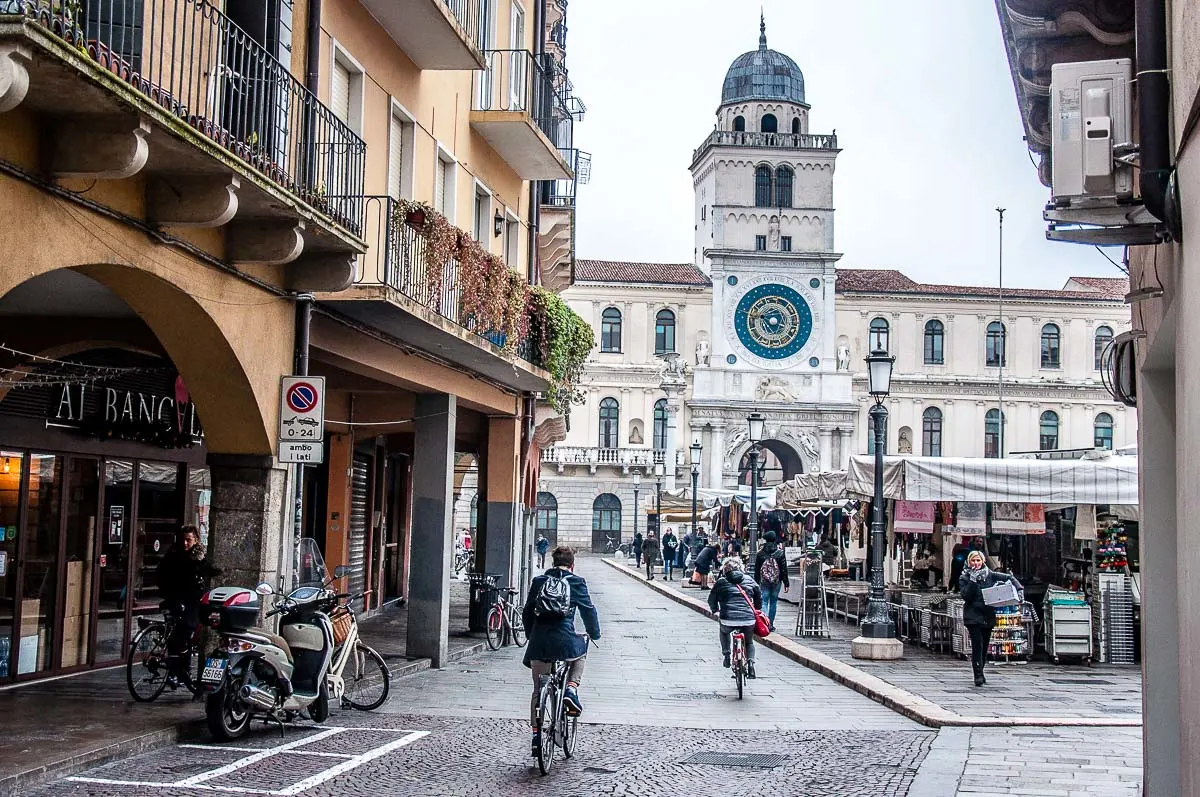
Nowadays, Padua is one of the most important cultural and economic centres in Northern Italy. The city’s industrial area is one of the biggest in Europe.
Padua’s train station is one of the main hubs of the Italian railway system. You can easily and quickly reach Padua for a day trip (or a longer stay) from Milan, Verona, and Venice. The city also enjoys good connections by train with Rome, Bologna, and dozens of other smaller and bigger towns and cities in Northern and Central Italy. Have a look here for dozens of ideas on which places are easy to reach by train from Padua.
Padua is easy to reach from four airports: Venezia Marco Polo Airport, International Airport Treviso Antonio Canova, Verona Valerio Catullo Airport, and Bologna Guglielmo Marconi Airport. You can find details on travel options and times from each airport to Padua by checking point 6 in this blog post.
According to official data, about 215,000 people live in Padua.
In addition, close to 63,000 students are enrolled at the University of Padua. This equals approximately 1 student per 3.5 inhabitants and gives the city a fresh young vibe. You can best experience it in the evenings when the squares in the historic centre fill up with people sipping an aperitivo and socialising with their friends.
Graduation days are also big in Padua, Italy. This is when you can see the University’s graduates dressed in their black robes and wearing wreaths made of real laurel leaves on their heads. The laurel wreath tradition originated at the University of Padua several centuries ago and then it spread to all Italian Universities. In fact, a graduate student is called laureato in Italian.
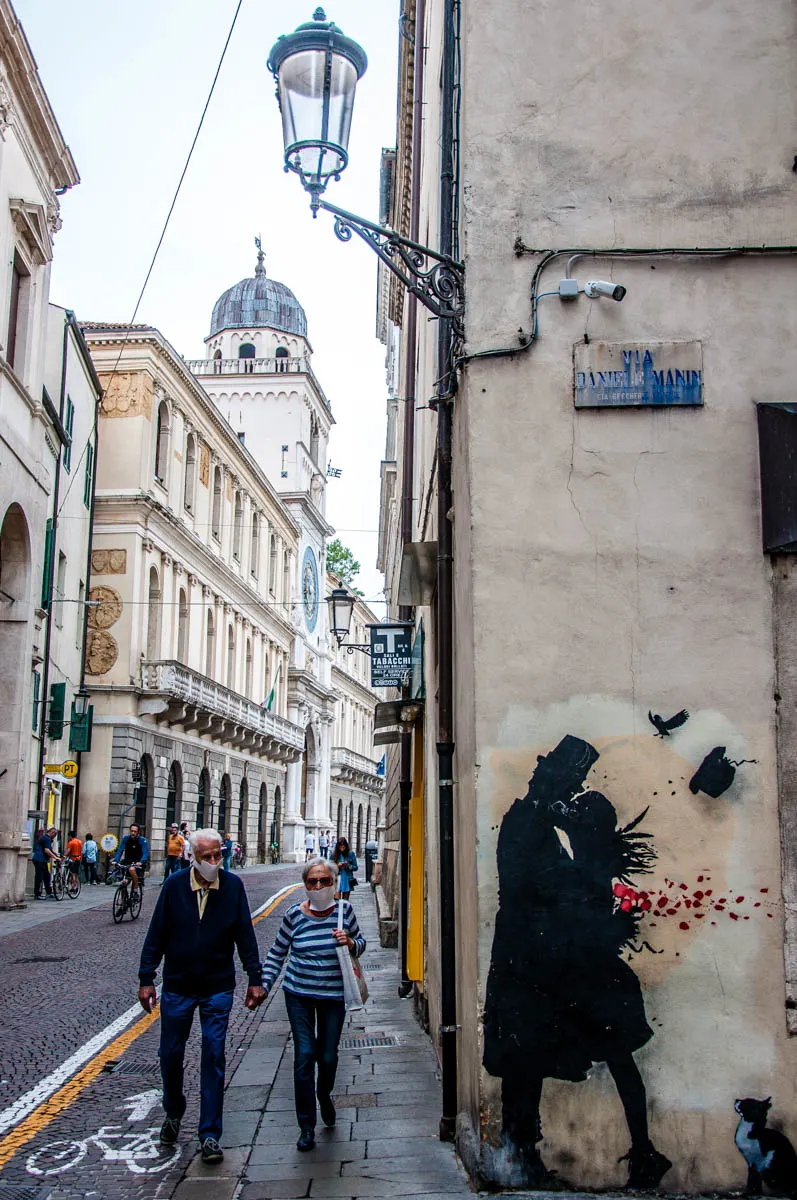
While Padua is famous for its medieval and Renaissance frescoed buildings, don’t expect to see just old-school frescoes here. The city is home to one of the best graffiti artists in Italy, too. You will see Kenny Random’s murals all over Padua – both in the historic centre and further afield. The murals are very evocative. When you come across them either on the busy central streets or in the quiet side alleys, they make you stop in your tracks and a wave of emotion washes over you.
…And Let’s Finish with One Curious Fact About Padua, Italy
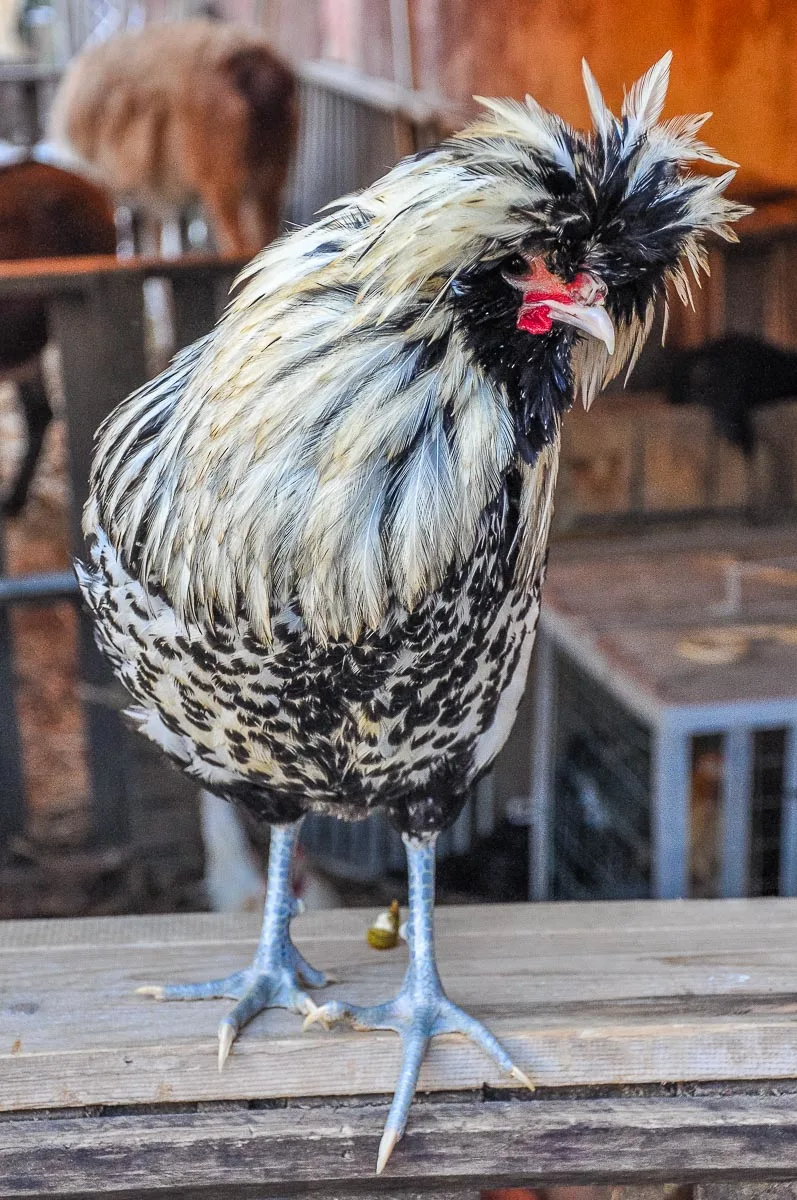
Padua is proud to have its own breed of chicken!
As you can see above, the Padovana chicken looks really cool. Instead of a crest, it has a tuft of long feathers on top of its head. Originally imported from Poland in 1500, the breed took well to Padua’s climate and soon took the city’s name.
The Padovana chicken lays lots of eggs and has excellent meat. Above all, it looks simply gorgeous. The tuft of feathers is not just ornamental, though. Apparently, it helps the chicken keep warm during the cold winter months.
In Conclusion
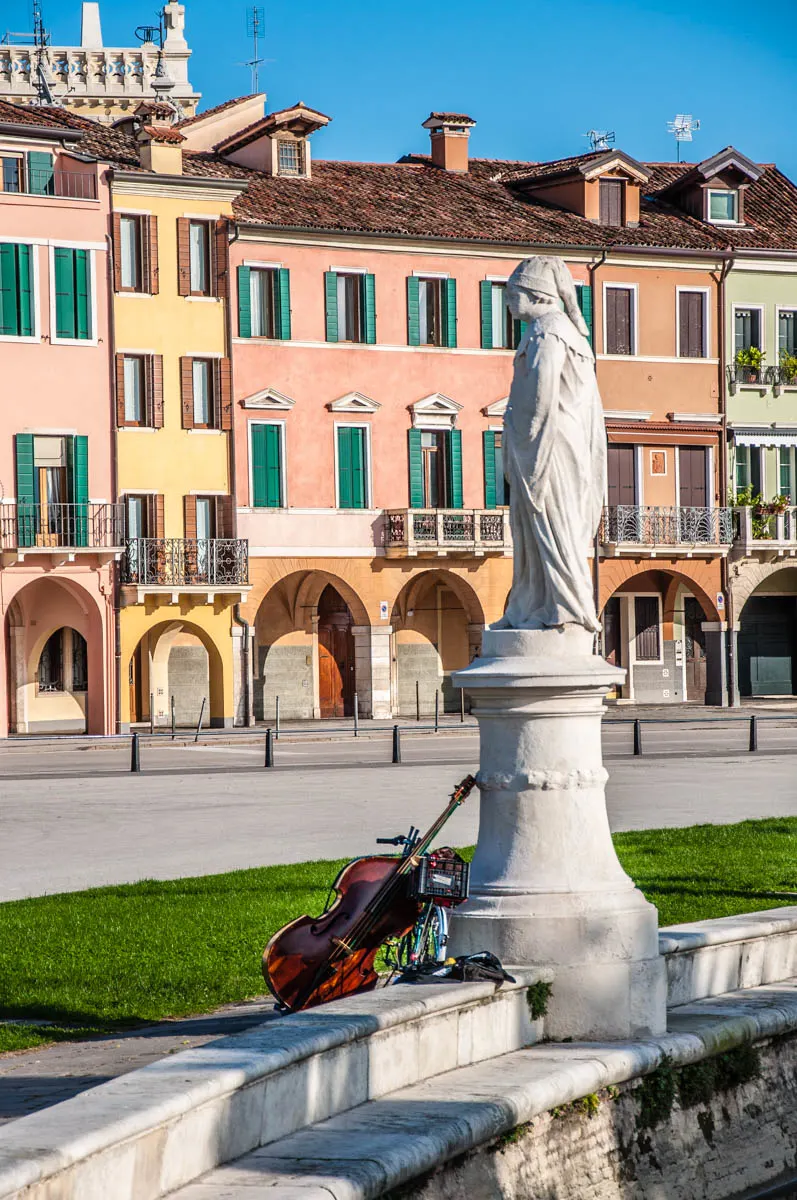
Padua is a city in the Northern Italian region of the Veneto. Right between Venice and Verona, Padua is often overlooked for one of these worldwide famous tourist magnets.
Yet, Padua has a lot to offer to the discerning traveller. From the first masterpiece of the Italian Renaissance to Italy’s second-oldest University and the world’s oldest academic botanical garden, there is a long list of unmissable sights to explore here.
In the above blog post, I share with you 101 facts about Padua, Italy. Organised in ten groups, they offer you a way to get to know the city, its history, art, churches, and famous personalities. I have also recommended the relevant sights to visit for each group of facts. This way, you can use this blog post as a thematic travel guide.
I hope that the information shared herewith will spark your interest in Padua and that before long this exciting Northern Italian city will be on top of your travel wishlist to visit as and when possible.
Enjoy exploring Padua!
More Helpful Links
- 10 Reasons to Visit Padua – A Must-See Italian City
- 13 Best Things to Do in Padua, Italy in One Day (Full Itinerary with Times, Photos, and Map)
- Day Trips from Padua, Italy – Over 35 Unmissable Destinations in the Veneto, Lombardy, and Emilia-Romagna
- Padua in the Run-Up to Christmas – Festive Lights, Chocolate, and Egyptian Artifacts
- Walking Around Padua – A Day of Slow Exploration
- Padua’s 800-Year-Old Market
- Exploring Padua – Palazzo della Ragione
- Padua’s Botanical Garden and the Basilica of Santa Giustina
- Padua’s Astronomical Clock – Where Time, Science, and History Await You
- The War on Art or the Loss and Reconstruction of the Mantegna Frescoes
- Video of the Diocesan Museum in Padua
- Video of Piazza dei Signori in Padua
- Video of the 800-year-old market in Padua
- 30 Days of Adventures in the Veneto, Italy – #30daysofadventures
- Top 15 Places to Visit in the Veneto, Italy – The Ultimate Guide
- 20 Best Things to Do and See in Verona, Italy in One Day – The Ultimate Itinerary with Photos and Tips
- 25 Best Things to Do in Vicenza – Northern Italy’s Hidden Gem
- 18 of the Best Cities to Visit in Northern Italy (With Travel Tips and Nearest Airports)
Thank you for reading! Please, leave me a comment, pin the image below or use the buttons right at the top and at the end of this blog post to share it on social media.
For more useful information like this, please, like my blog’s page on Facebook and subscribe to my strictly no-spam newsletter.
